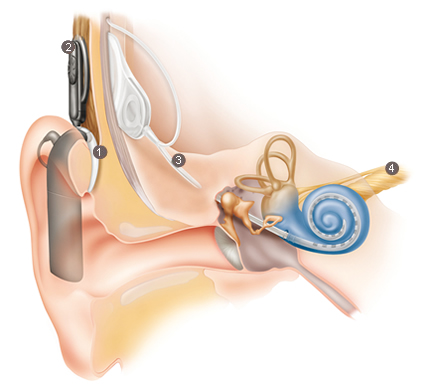ANC9 - evolution of headphones with active noise cancellation
This Monday we are in the BoxOverview blog, we’ll talk about headphones with an active noise reduction system - Audio-Technica ATH-ANC9
My colleague frag1k already wrote about the junior headphones of this series - ANC7 , and I will tell you about the older version - ANC9.
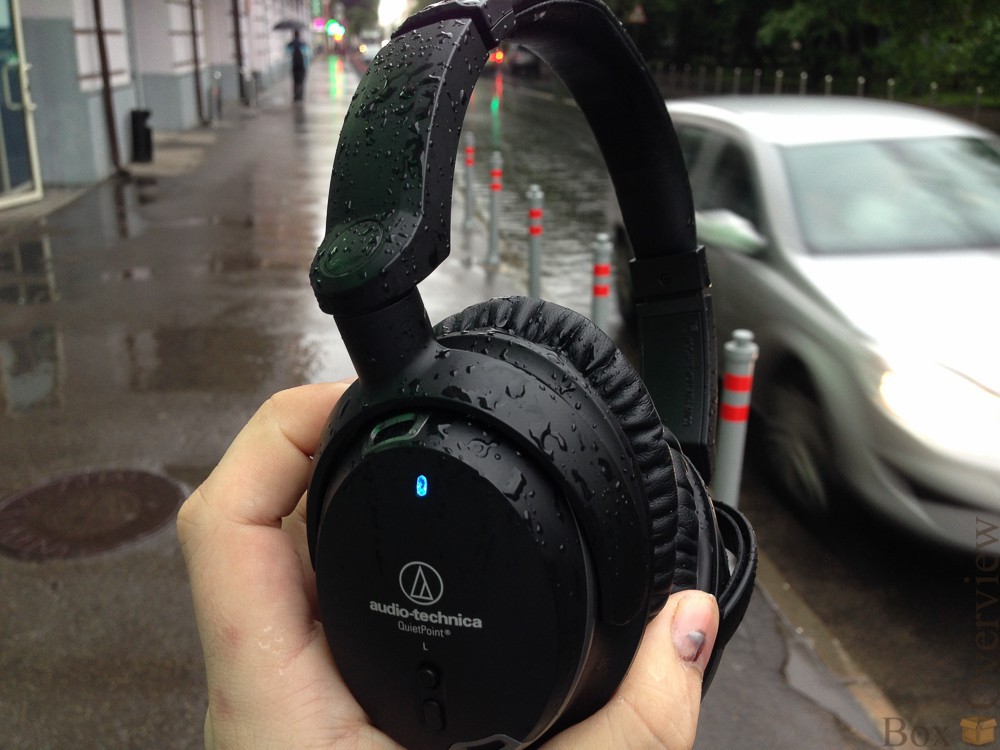
Under the cut, a traditional educational program in physics, medicine, biology, geek-porn, and, well, a review of headphones, not without it.
Appearance
What do we see immediately after we removed the box with headphones from the store? We see a box. The box looks like this:

It has the proud inscription that the headphones quench up to 95% of external noise.

The headphones themselves look like this:

On one side are the mode indicator, a mode switch button and a power switch.

The button cyclically switches the three modes of noise cancellation, the current is indicated by a three-color LED. The mode is saved when you turn it off (when you turn on the headphones, they will work in the mode set when turned off):
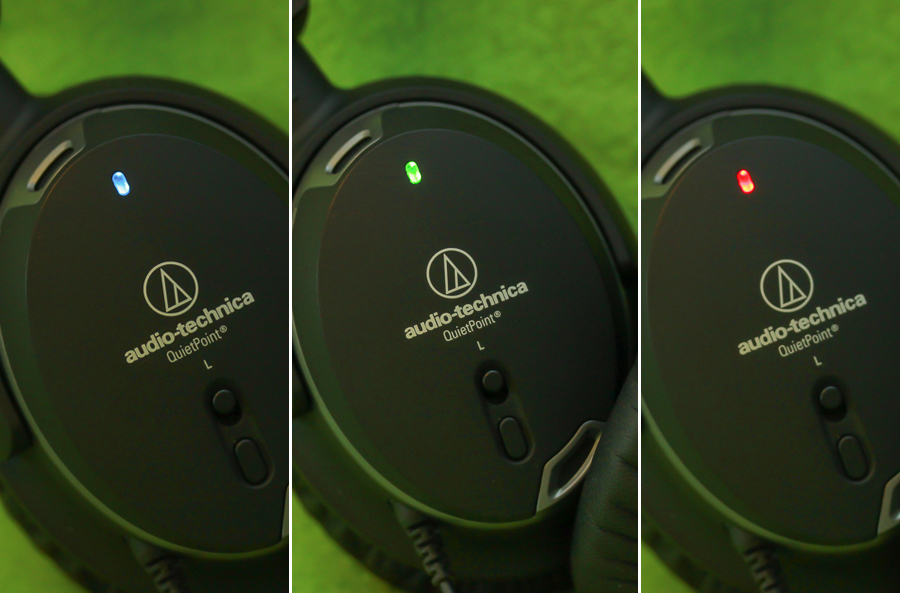
On the box there is a transcript of these modes:

As the pictures say, the first one dampens the sounds of low frequency, and is intended for airplanes, trains and various mechanisms. The second mode reduces higher-frequency sounds - conversations, different noises. The third is a low-power mode, and can be used for relatively quiet rooms.
')
There are two noticeable holes for microphones (we'll talk about them later):
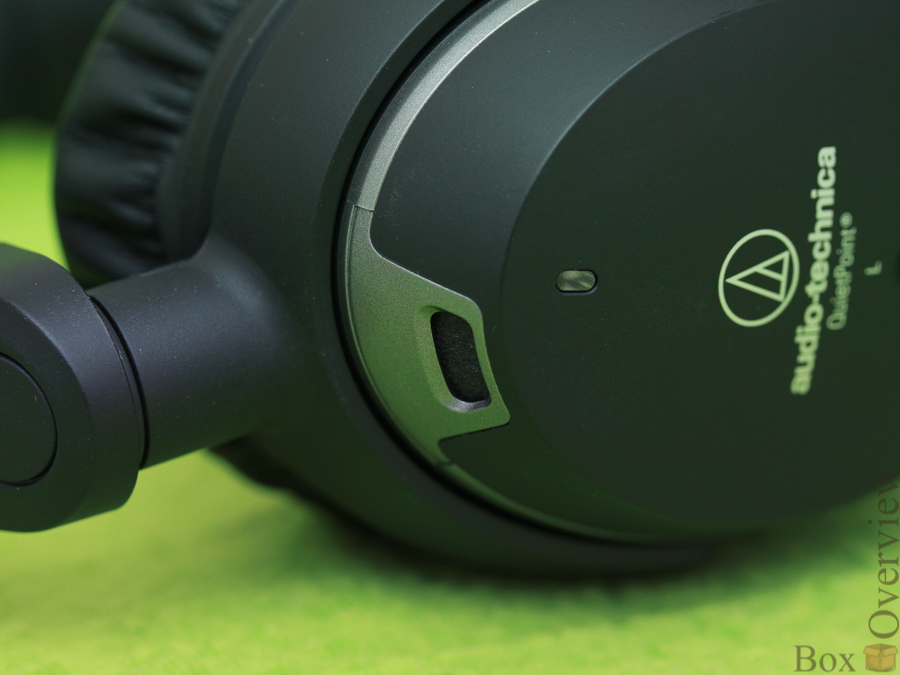
Below - a hole for the plug wire:
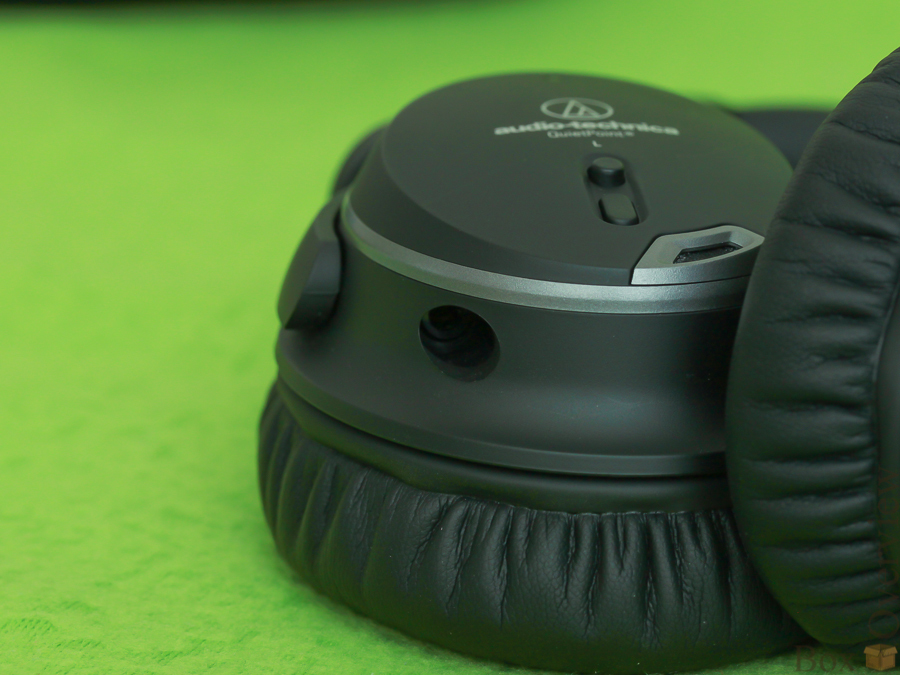
In the inserted state, it looks like this:
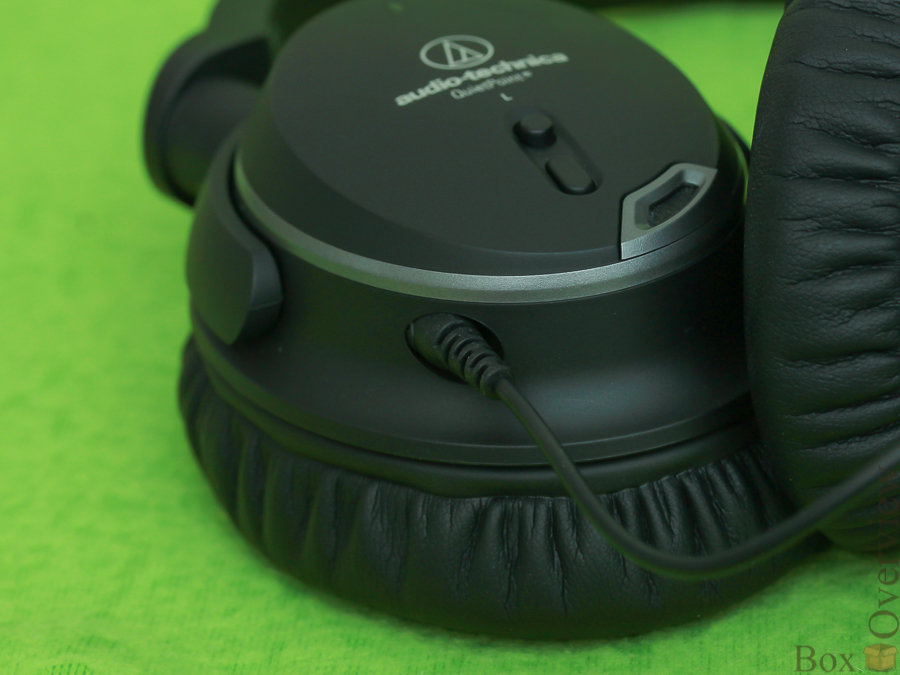
The wire is very thin and looks unreliable. Although its replacement in the event of a breakdown will not be a problem - jack-jack wires are sold anywhere.
On the other side of the headphones are the same microphone holes:

And battery connector:
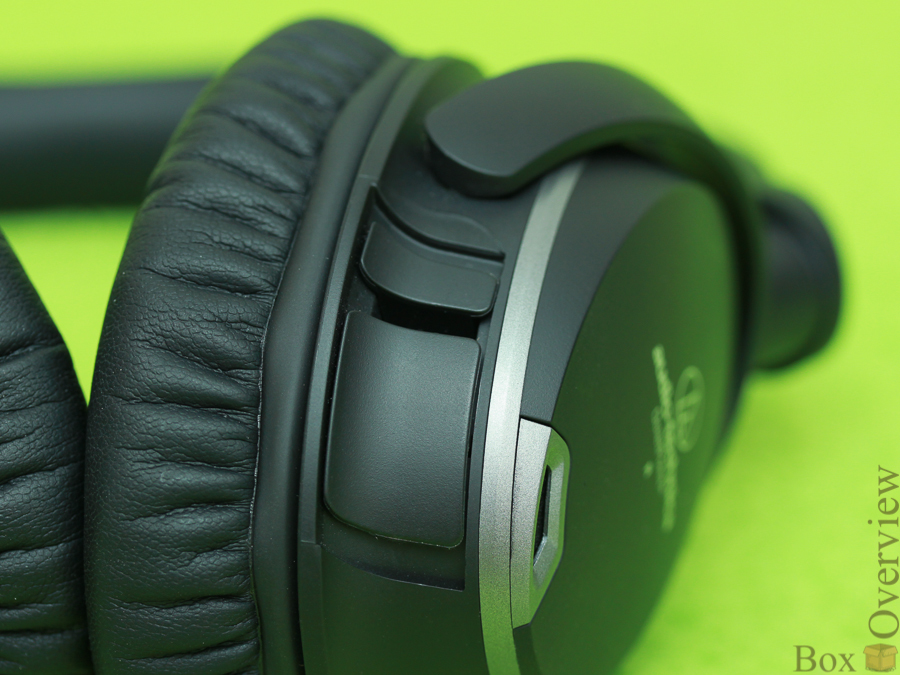
It is rather strangely made, not with a lid, but with a removable compartment:
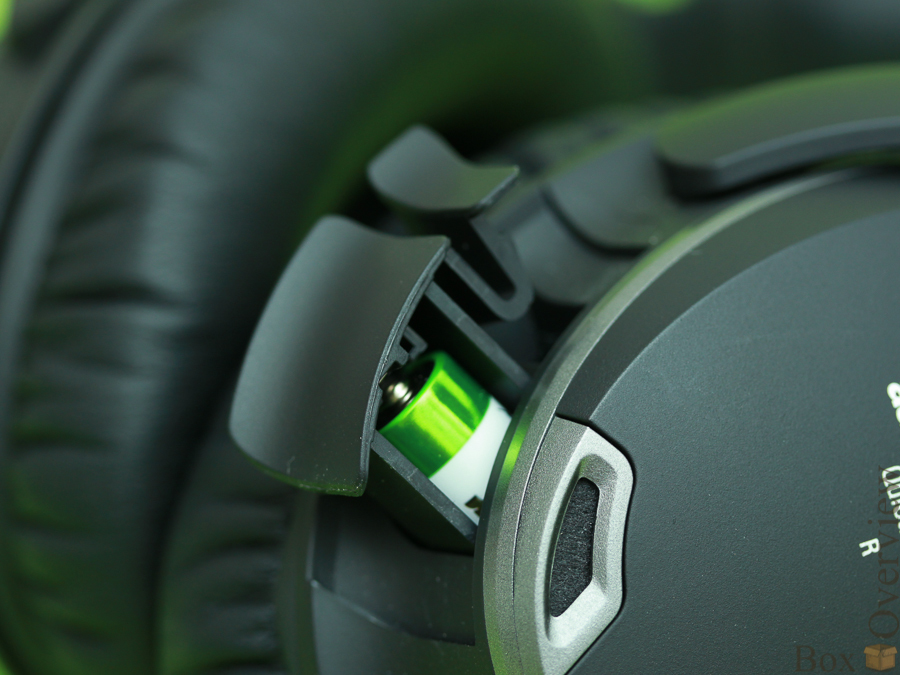
To replace it, you need to pull it out completely, and then it looks like this:

Replacement, by the way, is very difficult, if you don’t have something sharp like a screwdriver or a knife - the battery doesn’t come out of the compartment with your fingers, I broke my nail trying to do it. It is possible that the extended acrylic nail is able to do this, but I have relatives and are not so strong. I use a screwdriver from the multitool.
From the good - a very large range of adjustments, from this:
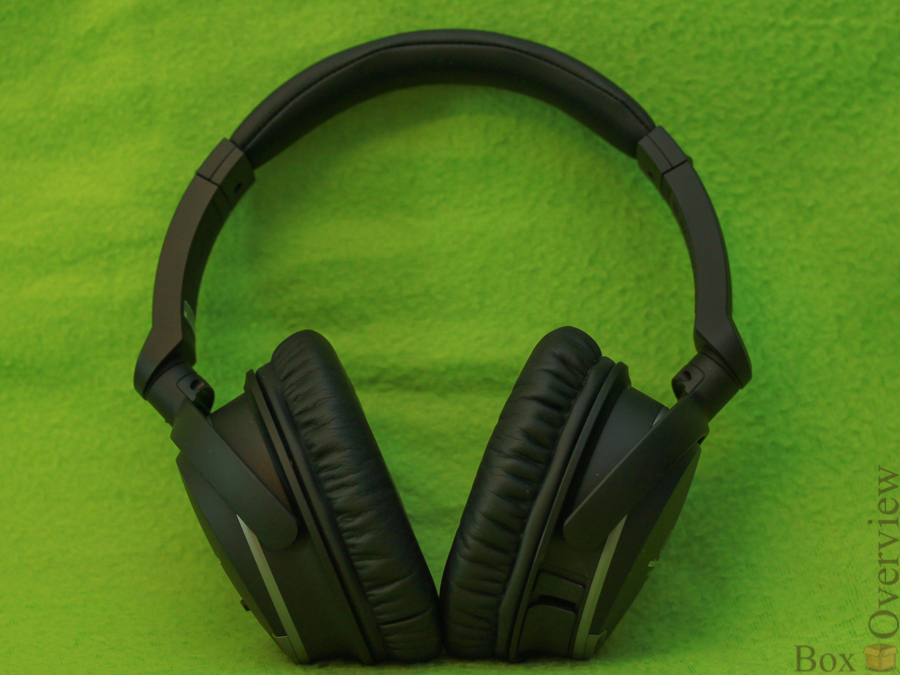
Before this:

They'll get even a big head. The cups themselves also have an independent “suspension”, they can rotate from the maximum angle:

To minimum:

Adjustments will be enough for any head, but the clamping force is still not enough, in my opinion. Headphones are very critical to the correct fit - sometimes, to achieve the maximum effect, they need to be moved on the head so that they surround the ears more closely. And then it is felt that if you press the cups with your hands, the external sounds disappear completely. But the headphones themselves are not capable of providing such a clamp, unfortunately.
Headphones do not leave the impression of strong and able to withstand any test. No, of course, they are collected well, and are not going to fall apart on their heads. Moreover, during the repair , I beat my head and headphones on the head about the protruding objects quite a couple of times, and they are still alive. The worst thing that happened to them - a few subtle scratches.
But to carry in a backpack in the same compartment with different angular and possibly sharp objects, like my previous Philips The Stretch, I would not. Apparently, manufacturers understand this, because the bundle includes a rather convenient case that will protect the headphones from the aggressive environment of my backpack:

With company label:

And for some reason, a carbine:
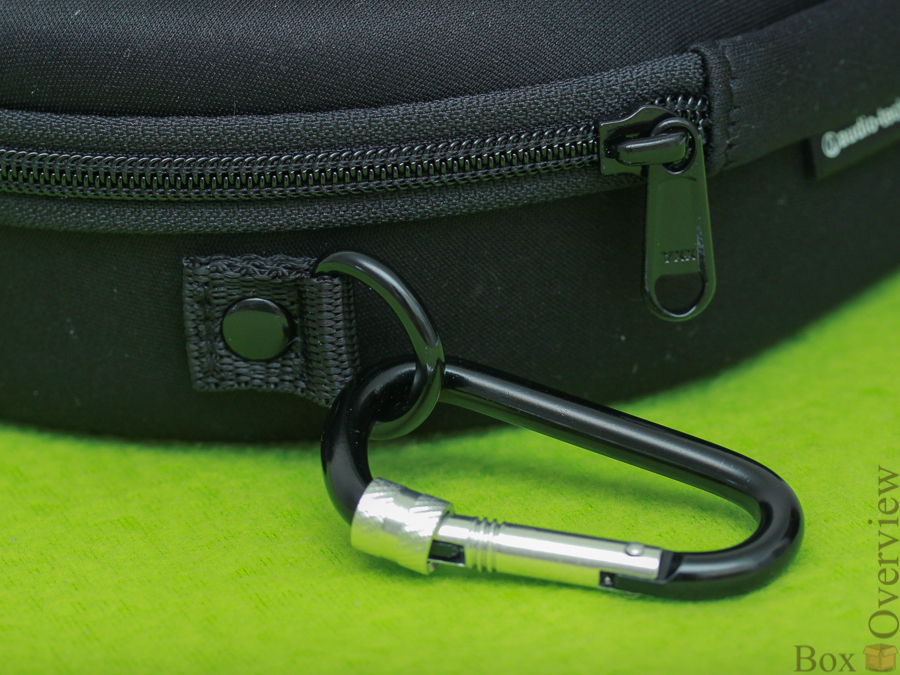
Why he, I did not understand. It is inconvenient to hang the case - it is too big for this, there is nothing to hang on it either. The only thing I came up with is that they can troll subscribers in an instagram (by the way, subscribe ).
It is bad that the headphones in this case take up quite a large part of the backpack.
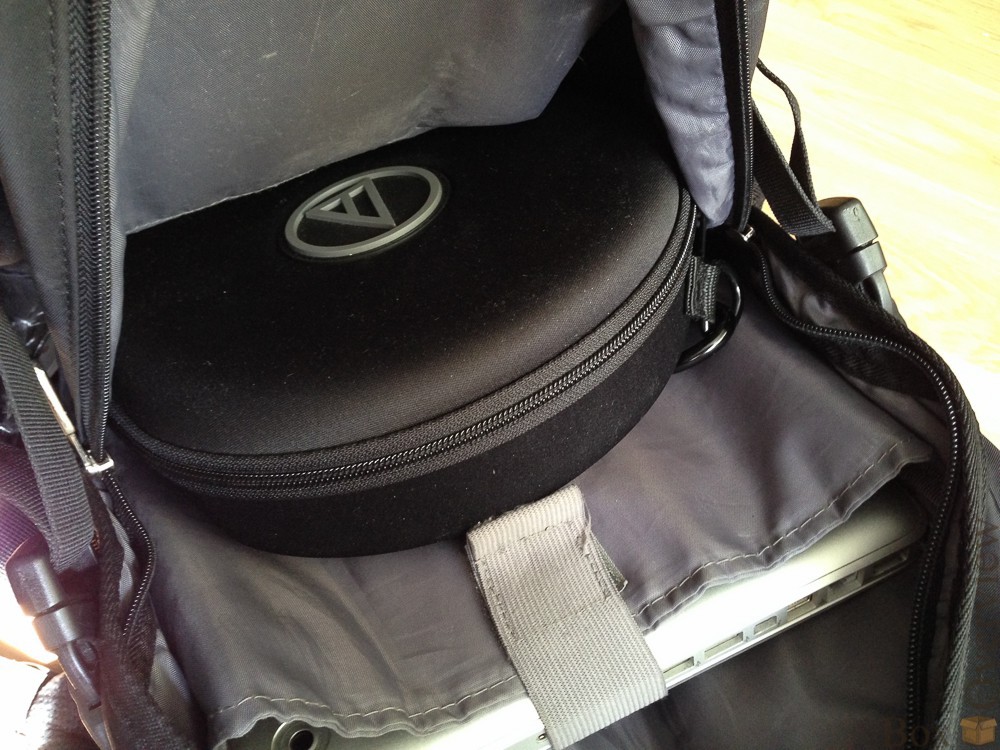
In addition to headphones, the case is full of free space:
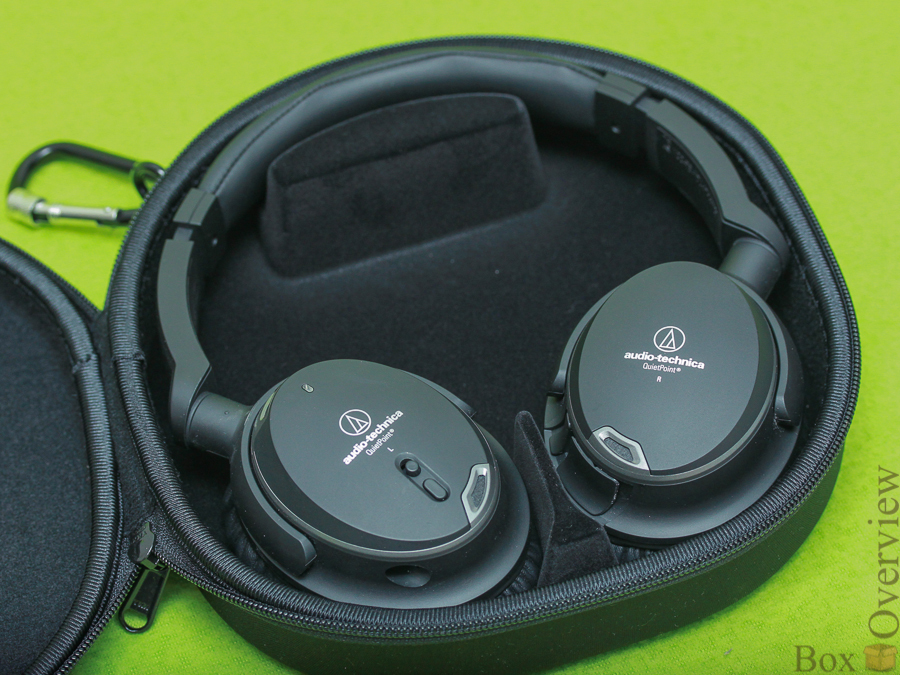
And there is a convenient pocket:

In which the complete set of headphones fits:

The battery also comes bundled, which pleases. In addition to it there are adapters for aircraft and 6.3mm:
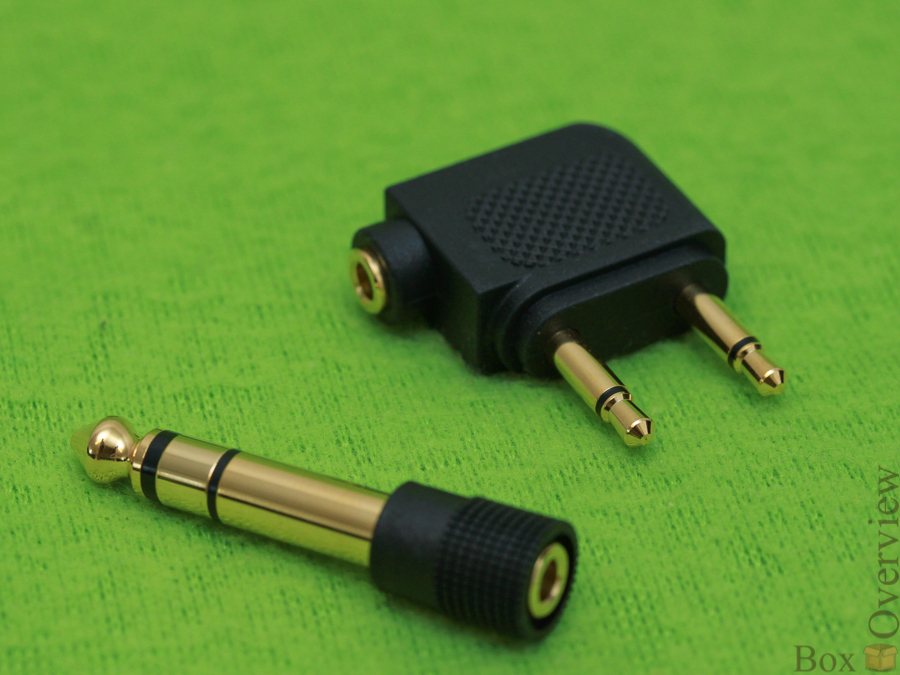
And two wiring - with or without a headset. They differ in connectors:

The one with 4 pins is with a headset. Apple's standard, but most phones now seem to understand it - my Xperia Z works correctly with both a microphone and a button.
On the headset wire is, in fact, a headset with a button and a microphone on the back:
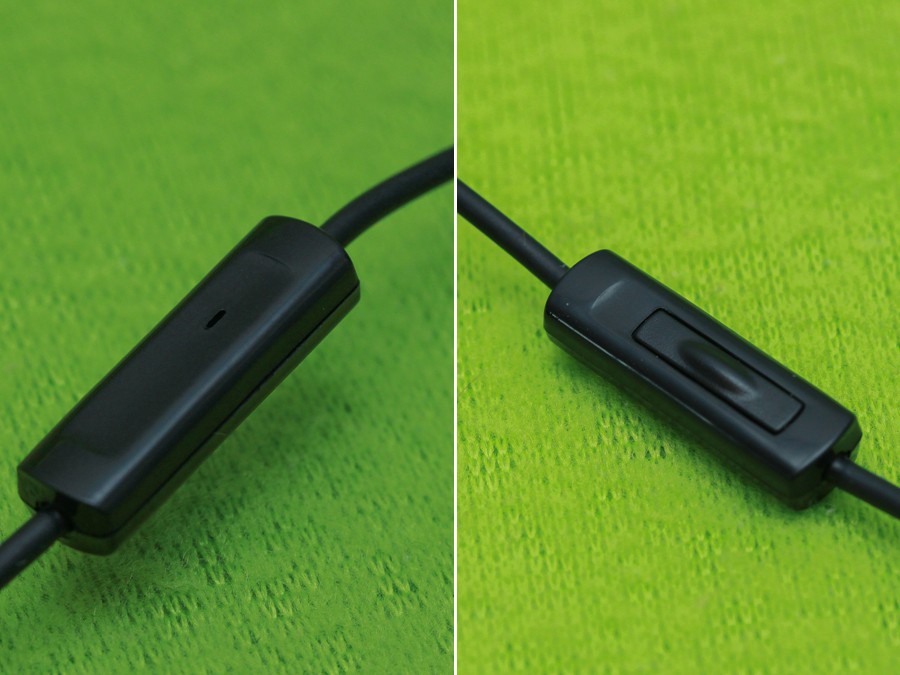
UPD: These lines are written a month after I wrote about the backpack and cover. My innate laziness made me check the strength of the headphones - I stopped carrying the case completely, leaving it to live at home, and began to wear headphones with me. They endured. They held my backpack , in which in the section with headphones there are keys, handles, trifles, pliers, a knife, screwdrivers, wiring with connectors and many other sharp and hard pieces.
We withstood the rain and wind (see the title picture), daily trips to the subway, airplane flights in luggage and hand luggage, weathered drops from the head and head-butts on protruding objects.
I admit, I was wrong. Headphones durable and withstand everything. But why then they cover?
Interior
Naturally, any device must be disassembled. After not having disassembled it, we cannot be considered its full-fledged owner. If we took apart even the multicookers, then we will sort the headphones even more. Remove ear cushions, gently tightening the fabric from the sides:

We see the noise reduction microphone and speaker. The bulge below the speaker is the battery compartment.
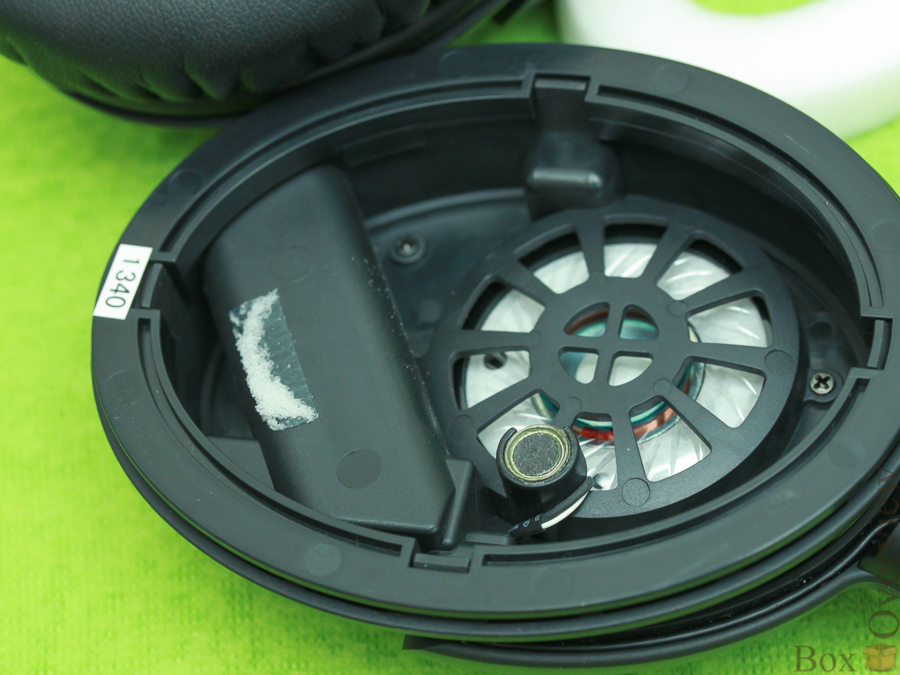
Naturally, the second earpiece is the same, but empty - so that both cups have the same sound characteristics:
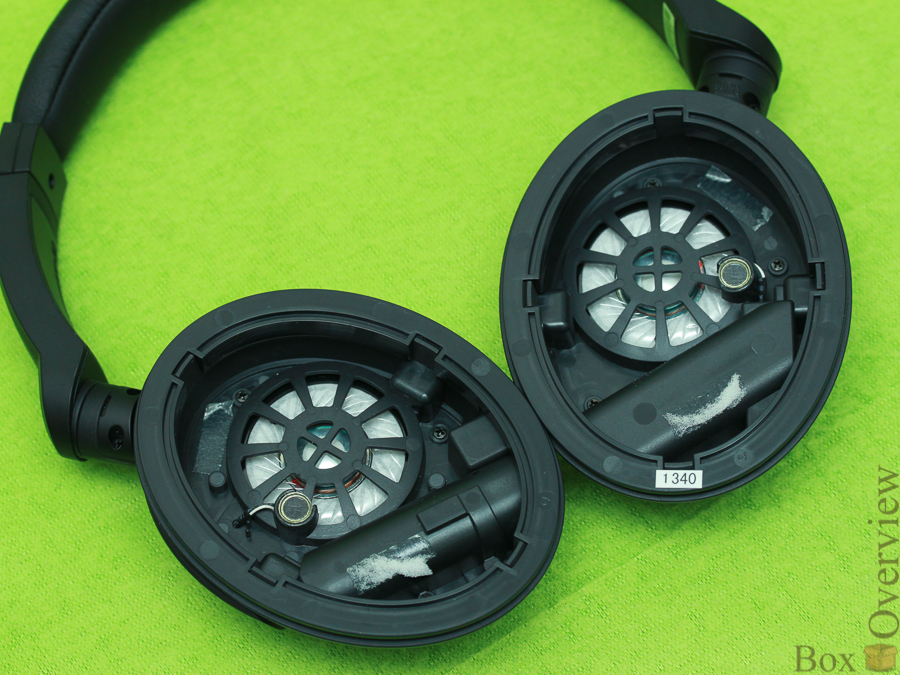
We unscrew the three screws in the depth of the earpiece and removing the outer cap, we get to the most delicious - the board:
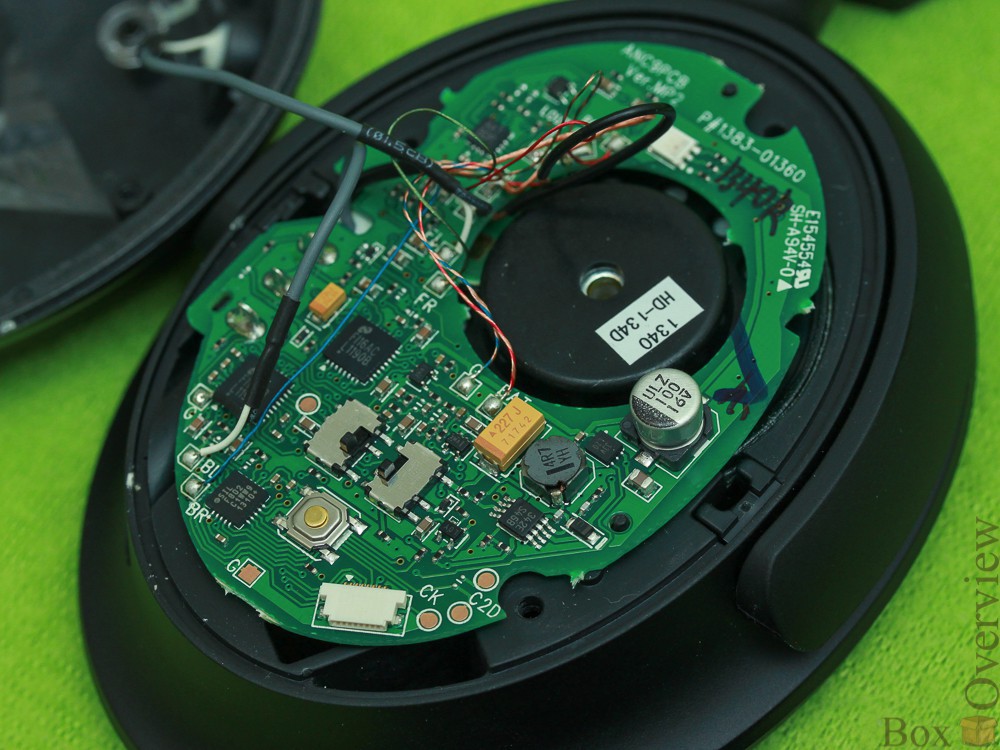
What we have here is interesting? For example, a double switch. More precisely, even two dual switches - each for two channels:
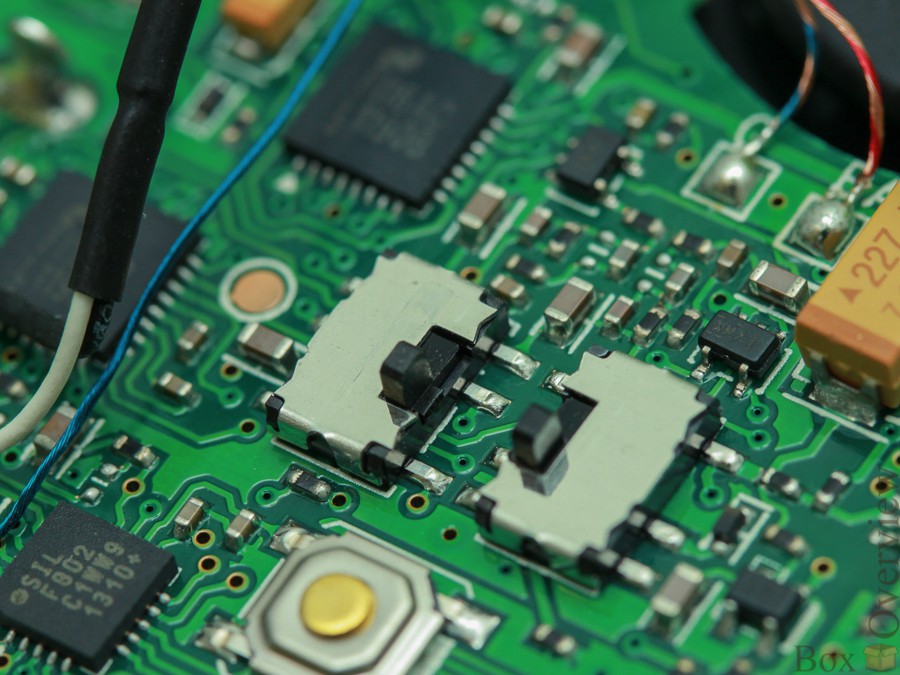
It is necessary to work without a battery - in the off state, the sound is transmitted directly to the speakers, without getting into the audio path, which cannot operate without power. And when you turn on one switch physically chops off the sound source from the speakers, redirecting it to the amplifier, and the second supplies power to this same amplifier.
Below is the button for changing modes:

And above - LED indication modes:
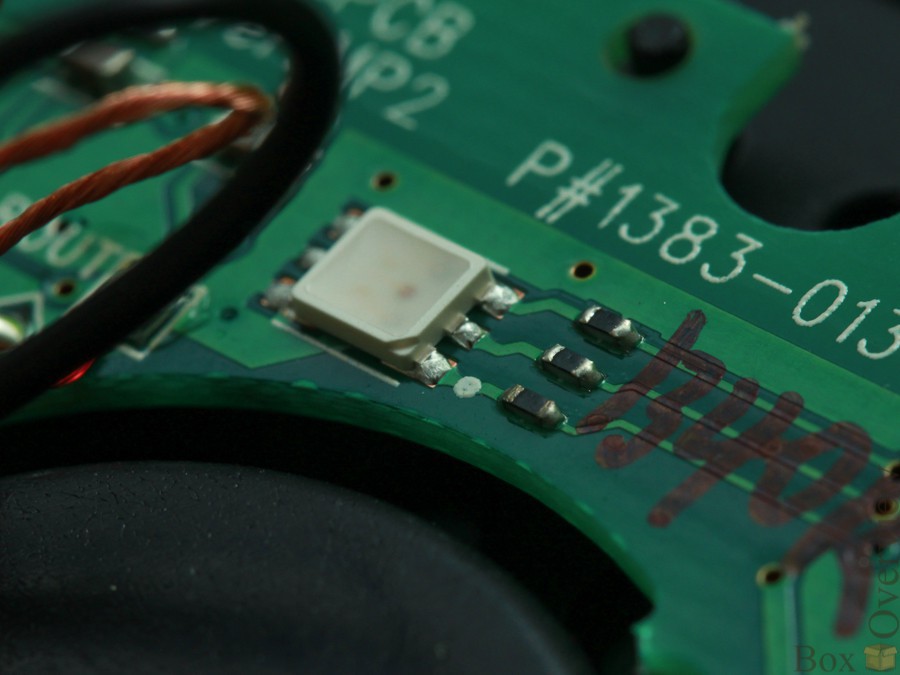
Some kind of connector for debugging or programming:

Two incomprehensible chips, with similar markings that could not be found. That it remains only to guess - maybe DSP for different channels, maybe something analog, maybe ADC and DAC.
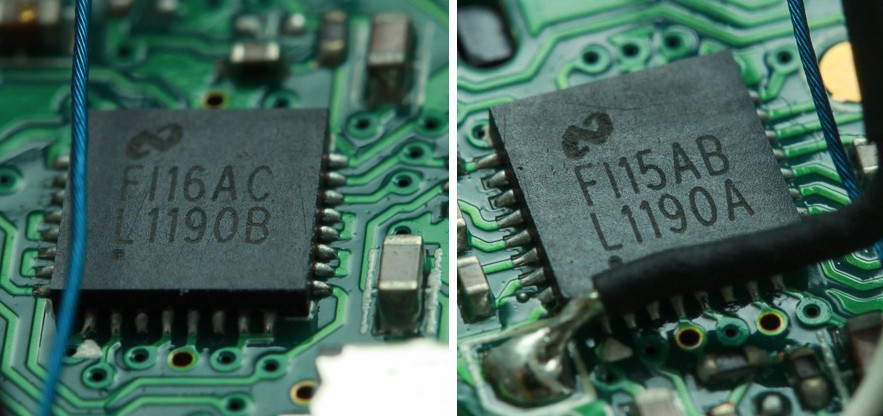
Like the previous two, the appointment of this chip is also a mystery:

To be honest, I'm a little sad. Disassemble something dismantled, but to understand the meaning of the work is not particularly close.
Go ahead. Microphone:

Moreover, one. No, that's right - we were promised two microphones, we have two microphones, one inside and one outside. Just funny is that the lower mesh, which looks like another microphone turned out to be a sham:
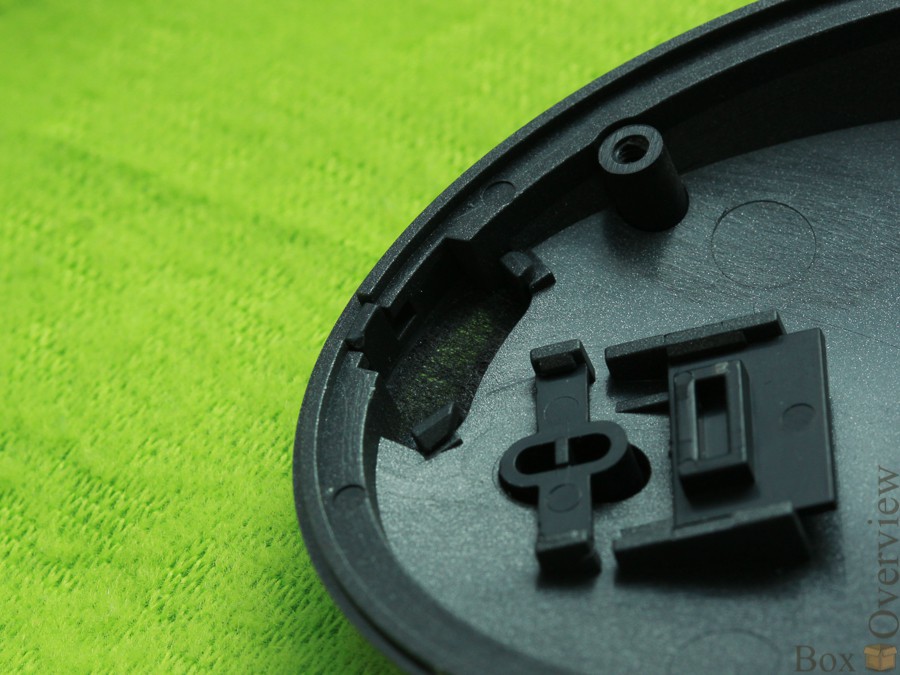
You can still open the second earpiece, but we will not see anything particularly interesting there - a small scarf, the only purpose of which is to connect the wires. From it it is clear that the headphones connect 6 wires:nine people, seven dwarfs .. power, two microphones, a speaker, and two lands - digital for power and analog for microphones and a speaker.
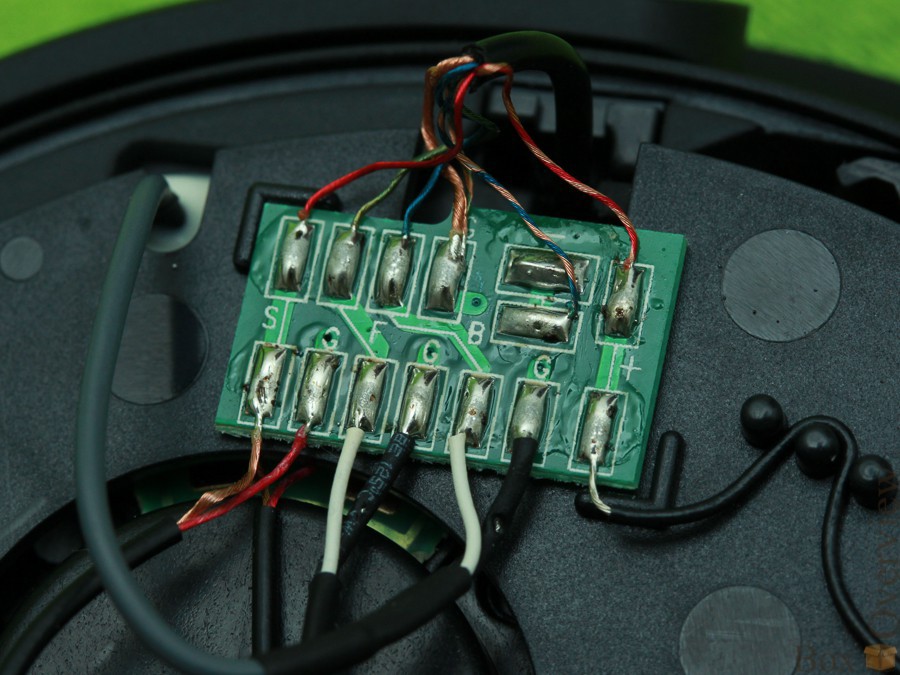
Also located on this part: a microphone (and another inside), battery contacts:
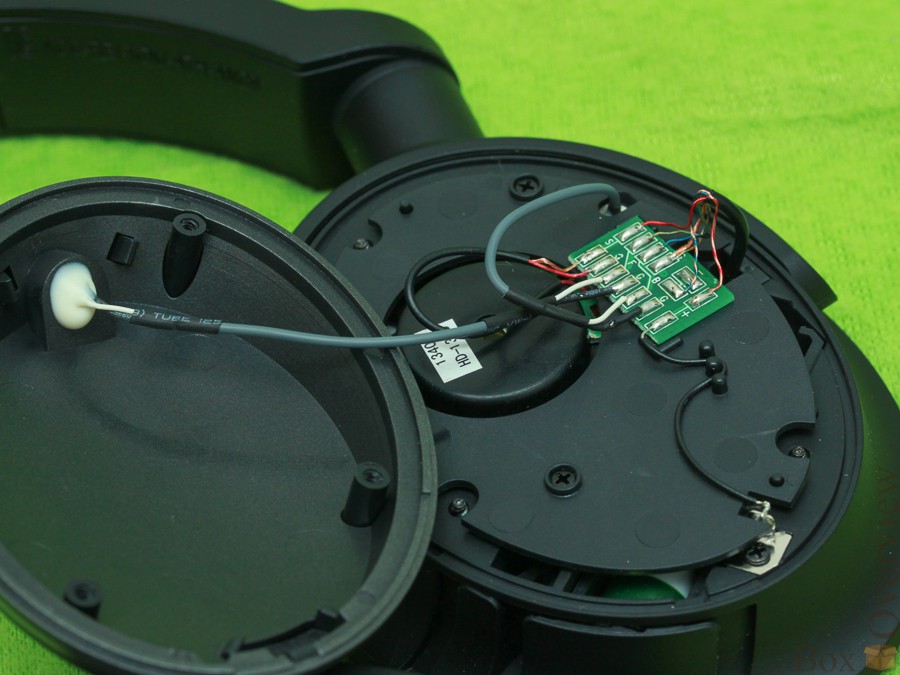
By the way, the insides have changed quite a lot compared to the previous model:
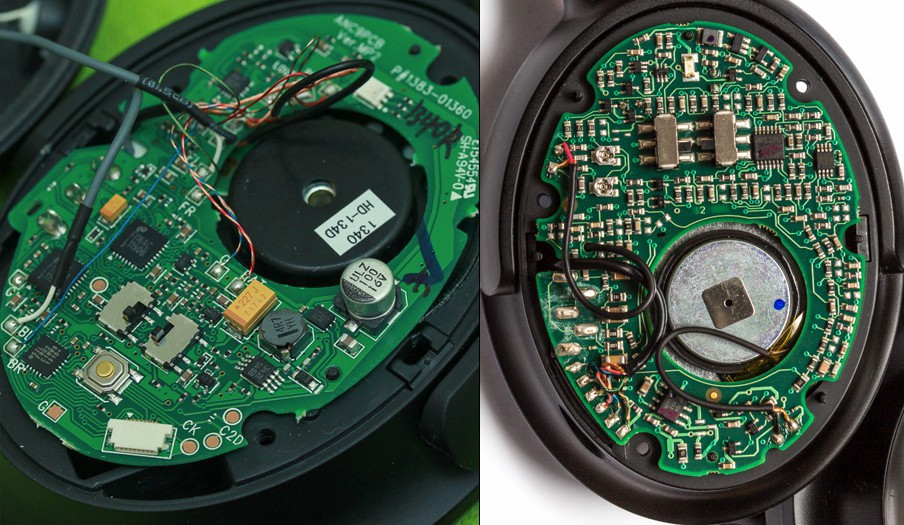
I have little knowledge of audio technology, but it seems to me that part of the analog path was replaced by a number.
Specifications
Honestly, I don’t really look at the characteristics, but some people prefer to listen to headphones instead of music :)
Especially for them - a sign:
If everything is clear with the weight, type, frequency range, cable and plug, then with the item “Squelch level: up to 30 dB, depending on the mode,” questions arise. How many times does the noise decrease? What are these decibels? Well, well, since there are questions, you will have to answer.
What is decibels?
I remember from school that the sound volume is measured in decibels. And in some children's encyclopedia there was a picture from which I firmly remembered that the noise of a rocket taking off was 150 decibels, and that it was above the pain threshold. True, I never saw a rocket taking off in my life.
But if I had been asked about what kind of value this is - decibels, I could not answer. Honestly, in a school textbook, some kind of turbidity was written: “Unit of measure in 1 decibel (dB) is defined as the decimal logarithm of the quotient between two physical quantities for which the unit of measure is power (energy per unit time)”
Well, who in their right mind, without need, will try to comprehend this sentence? No one. It is easier to memorize and tell at the exam, but it is not necessary to understand this. In fact, everything is very simple.
We all remember Alexander Bell - the man who invented the phone (although, suddenly, Wikipedia says he didn’t invent the phone, but he invented a peeling machine, a metal detector, a vacuum pump and a kite. He also founded National Geographic).
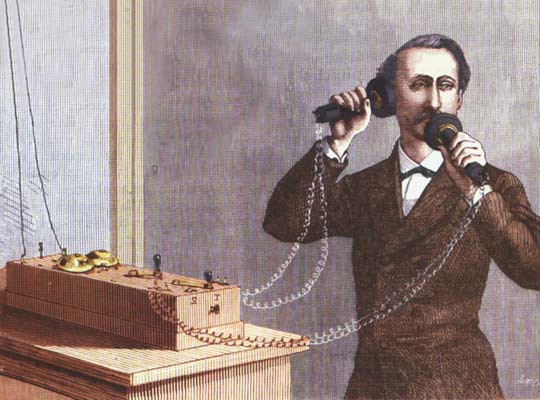
So, in the process of studying sound processes, he also tested human hearing - determined the quietest and loudest sound that a person can hear. He applied the sound of exactly measured power to the speakers and, making a correction for the efficiency and sound absorption in the air and at the medium boundaries, determined what radiation density is needed for minimum audibility of sound, and after whichof the ears blood begins to flow a person feels pain. He found out that children with eyes closed and after adaptation in complete silence begin to hear a sound with an intensity of only 10 picowatts / m². 10 powatts distributed on the surface per square meter, think about it! This is despite the fact that the area of the eardrum also is only 55 mm² - half of the tetrad cell, which means it receives only 0.0001 of this energy.
The maximum load on the ears of a healthy middle-aged person before the onset of pain was 10 watts / m². A PW is a watt of -12 degrees, or 0.000000000001 watts. Thus, a person’s ears have a dynamic range that covers 13 orders of power - in order to get the loudest sound, you need to amplify the quietest 100,000,000,000 times. Cool! It is like a power supply that can produce voltages from 1 volt to 1000 kilovolts. Like a car, the engine of which can vary power from the power of a small kettle (horsepower, 700W) to 7 petawatts (for comparison, the power of all nuclear power plants in the world is estimated at 0.4 terawatts, or 0.004 petawatts). Apparently, Bell, too, was a little ohrenel from this, and did not come up with anything better than how to divide the entire range of hearing into 13 parts and call them in his honor - white. It turns out that when you increase the volume by 1 white, the power (and the volume) of the sound increases 10 times. Two times - 100 times, and so on. However, later it turned out that the white is too large a unit, and it is not very convenient to use it (the size of bacteria can also be measured in millimeters, but it is much more convenient to do it in micrometers), so they began to use DBS - 1/10 of the white. Accordingly, an increase of 1 dB is an increase of approximately 1.26 times. If ten times multiplied by 1.26, you get 10.
Well, about 10: 1.26 * 1.26 * 1.26 * 1.26 * 1.26 * 1.26 * 1.26 * 1.26 * 1.26 * 1.26 = 10.08568
The most important thing - you need to understand that the decibel itself is a dimensionless quantity, even though it pretends to be dimensional. Without reference to the zero value, the decibel only shows how many times the value has changed. If we say that the sound level fell by 5 decibels, this means that its power compared to the previous value fell 3 kopecks times (10 ^ (5/10) = 3.16). And if the power is raised 50 times, it will give +17 dB to the volume (10 * lg (50) = 16.99)
But how, if decibels are a dimensionless quantity (as percentages), do they measure loudness, power, voltage, and so on? Very simple - taking for zero dB any value (it is called the reference). The value in each case is different, because zero for the reference value can not be taken by definition - by increasing the zero by half, we still remain with zero. Thus, the decibel produced a whole brood of different units of measurement:
dBm (dBm) is the unit of power. It measures the power of signals (it may be familiar to you from the display on a modem or telephone), the sensitivity of receivers, the power of transmitters, and so on.
The reference level is 1 mW (this power is considered to be at a nominal load, such as 50 ohms for radio engineering). Thus, a 20 mW signal is 13 dBm, and a 0.3 mW signal is -5 dBm

One of the variants of the signal indicator in the CM shows just the dBm value in the receiver path.
dBV (dBV) and younger brother dBuV (dBµV) are voltage units. The first is used in audio equipment, the second in radio. The reference voltages are 1 volt and 1 microvolt, respectively.
Here, for example, the screen of some device for configuring satellite antennas:

dBi (dBi) familiar to everyone who has ever chosen a router or antenna to it. Or put the satellite receiver. Fully called dull and abstruse: “isotropic decibels (decibels relative to an isotropic radiator),” but in reality everything is simple. An isotropic radiator (iso-equal from Latin words, and tropos is a character) is an antenna whose radiation pattern is a level sphere. This means that such an antenna radiates uniformly in all directions. There are no such antennas, and they are not really needed in the real world.
So, dBi shows how a real antenna with this parameter emits stronger than isotropic. I think everyone understands that the antenna cannot radiate more strongly than the transmitter, therefore the gain is achieved due to the compression of the radiation pattern - the antenna radiates more to one side than the other. The situation is about the same as with photographic equipment, only instead of the transmitter power - the number of pixels on the matrix, and instead of the antenna - the lens. By changing the lens on the telephoto you won’t achieve an increase in the resolution of the photo, but by reducing the field of view, the quality of the photo of a distant object will be better for you. True, another problem arises here: those who shot with a telephoto know how difficult it is to keep a remote object in the frame without a tripod. With antennas, the same problem - even the best narrowly focused antennas are not very precisely directed at each other, will not work, or will work poorly - the bulk of the radiation will go past and uselessly dissipate in space.
Each normal antenna in the description has a picture similar to this:

This is the directivity pattern. One of them shows the horizontal, and the other - the vertical directivity of the radiation.
In 3d it will look something like this:
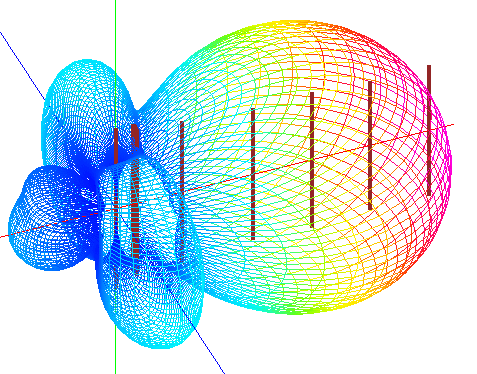
The largest "bubble" calls the main petal (there may be several, by the way), and the rest - side or side. As a rule, they are not used in work, and therefore they are trying to get rid of them - they only draw off part of the transmitter power.
For example, here is the radiation pattern from a very directional antenna:

There is also such a tricky thing as dBFS - dB Full Scale , when the maximum value of any scale of the instrument is taken as 0 dB. If we have a voltmeter scale of 1 volt, then 0.5 volt it will be -6 dB.
Here is the scale of my voice recorder with dBFS:

It is necessary mainly for digital recording - the ADC is adjusted to the maximum volume level in order to avoid overloading - clipping. Suppose if you have a signal with an amplitude of one and a half volts, and you adjust the upper limit of the ADC input to 1.6 V in order to get a signal of a higher resolution from the output. But now, if you give a signal with an amplitude greater than one and a half volts - for example, two, then the output of the ADC will still be equal to one and a half volts, because the ADC simply does not have enough capacity to show you two volts. Accordingly, the information contained in the part of the signal exceeding one and a half volts will be lost when digitizing. Therefore, everyone familiar with the sound knows that a positive value (and even a zero value, the more common values are -9 or -18) dBFS is very bad, and needs to be corrected - as a rule, simply lower the volume of the input signal by reducing the gain, or connect a compressor / limiter that does the same thing, but only on problem areas.
But something I digress. Noise is also measured in decibels, and the unit is called dBSPL (dB Sound Pressure Level) . The sound pressure acts as a reference level, below which a person is not able to catch a sound - 20 μPa at a frequency of 1 kHz.
It is in these units that all sound level meters measure noise, although they are often not written about it. In addition, correction meters are necessarily present in the sound level meter, denoted A, B, C. They are necessary in order to bring the flat sensitivity of the microphone (it is also not flat, but at operating frequencies it also leads to flat) to the sensitivity of the human ear. It is not only not the same at different frequencies, but it also varies depending on the volume. Information about the sensitivity of the human ear, combined in one graph looks like this:
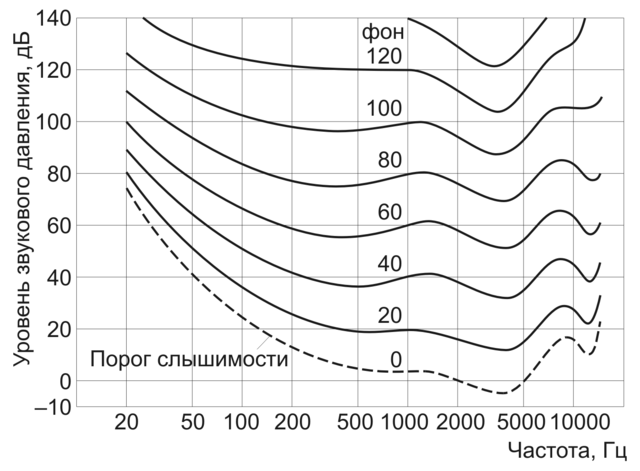
The lines themselves are called isophones, and together they make up a family of lines of equal loudness.
For example, the “0” point is precisely the quietest sound (20mKPa / 1kHz) that people can hear. However, the graph shows that at a frequency five times higher a person is able to hear the sound and with less sound pressure. And at a frequency of 8 kHz, on the contrary, the sound power should be almost twice as large.Just the correction mode "A" and leads the sensitivity of the microphone to the isophones. Mode B is a type A, but mode C is pure dBSPL, sound pressure expressed in decibels.
How the rumor works
But how can the human ear perceive such a large volume range? It's all about the structure of the ear.
Although, for the explanation it is worth starting with the fish. In fish, everything is arranged quite simply - their ear is combined with an equilibrium apparatus, which is also responsible for the feeling of acceleration. If we consider only hearing, then otoliths are responsible for it - calcite crystals (although not necessarily, some crayfish decided not to bother with their cultivation, and use just grains of sand instead), which are connected to sensitive cells. When a sound wave is applied to them, statoliths begin to oscillate, which causes the excitation of sensitive cells and the transmission of signals along the nerves to the brain. A sort of biological gyro:
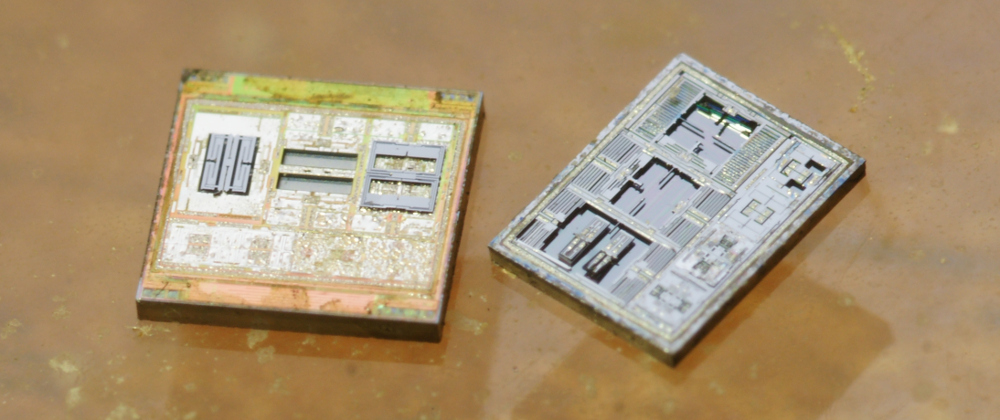
This whole structure is immersed in a liquid (it is called endolymph), and the sound is transmitted inwards through the membrane - a thin film that prevents the delicate device from contacting the external environment, but at the expense of its small thickness successfully transmits vibrations.
In the process of human evolution (more precisely, long before a person - in the process of going to land), a problem arose - on land, it was impossible to use such a design without changes, because when a wave passes from the air to a more dense environment, large energy losses occur.A bug was discovered in the Evolution tracker, I thought and thought and gave birth to just such a tricky structure:
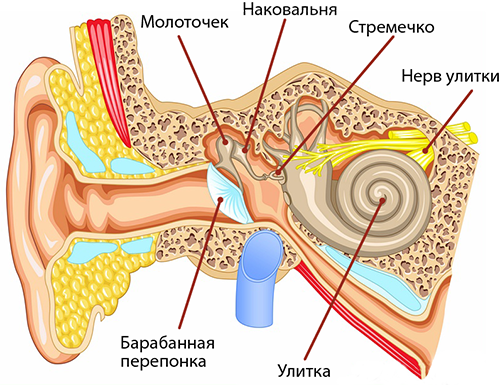
What the fish had - now it performs only the functions of the vestibular apparatus, and the duties of sound recognition are assigned to the thing called the cochlea. It is a structure of several channels whose diameter is not constant - the closer to the center, the smaller it is. Throughout the entire length of the cochlea, there are sensitive cells that react to fluctuations of the re-lymph. Here is the cool thing, the way different sound frequencies are recognized - the sound just comes into resonance with the walls of the cochlea, locally increasing the amplitude of oscillations in a certain place. High sounds will resonate with walls in the lower sections of the cochlea, and low sounds in the upper ones. In this way, you can determine the frequency of the sound from the place in the cochlea that generates the largest signal.The remaining parts, the eardrum, the hammer, the anvil, and the stirrup, form a “booster”, which, due to a cunning lever mechanism, increases the strength of sound vibrations by a factor of 20. However, due to amplitude, oscillations with a large amplitude, but with low pressure, enter the ear, and the stirrup transmits vibrations with a small amplitude to the cochlea, but with sufficient energy, so as not to fade when moving to another medium. In fact, this part of the ear is the impedance matching of water and air.
The tension of the eardrum and the position of the incus and stapes are regulated by special muscles. Because of this adaptive adjustment, the difference between the quietest and loudest sound is 13 orders of magnitude - in the absence of loud sounds, a certain period of time the muscles relax without interfering with oscillations of the ear bones. When you increase the volume, they are on the contrary, tense, extinguishing part of the movements.
Maximum volume, limits, and danger of loud noises
Despite the large range of sounds heard by the ear, and it has a limit. Here, for example, I made a compilation of several found volume tables of different sounds:
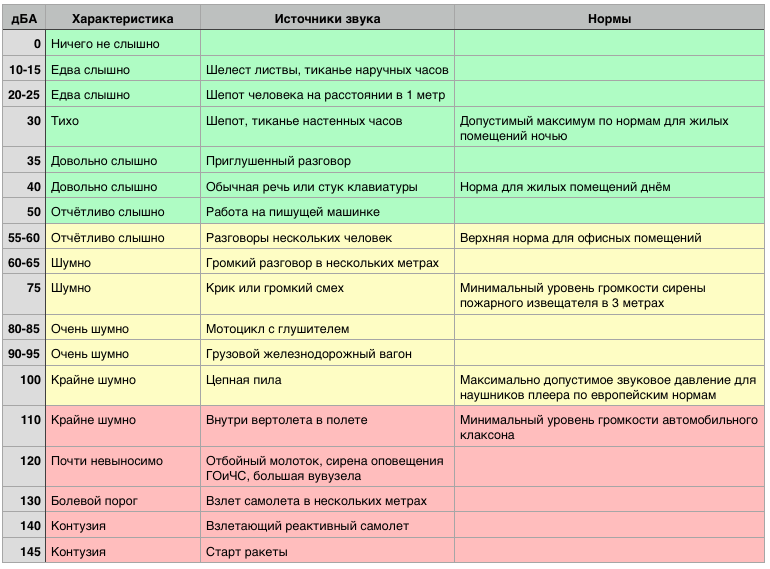
Then I walked a little with a sound level meter and confirmed the values in the table. Here, for example, the entrance of the house deep at night:
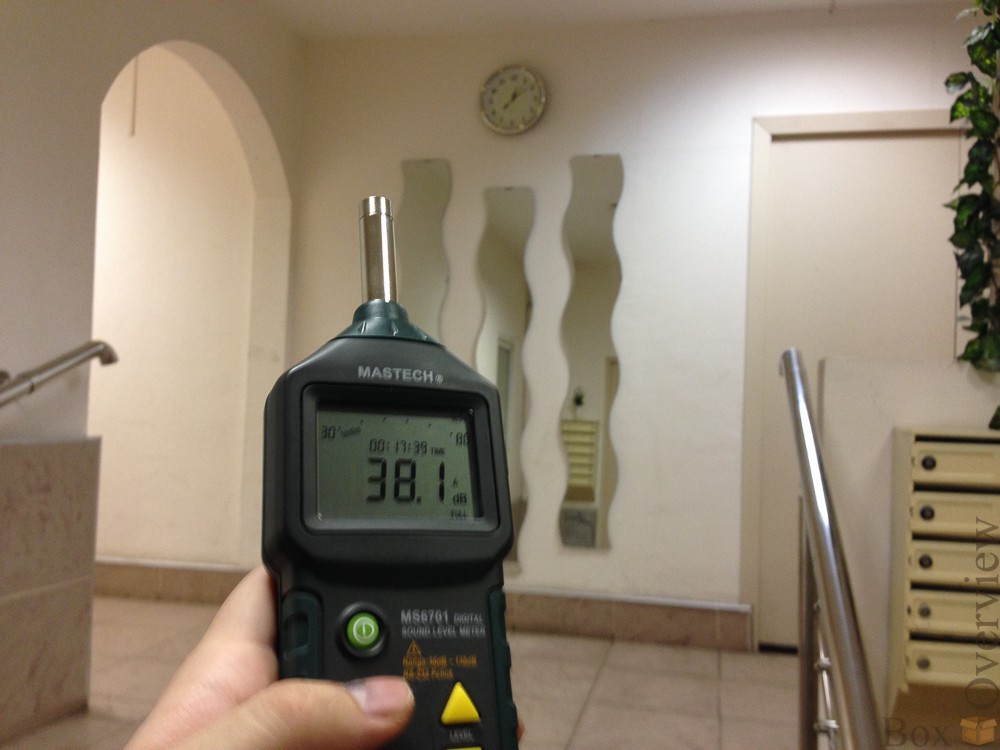
And here is the street - the noise is heard from the road:
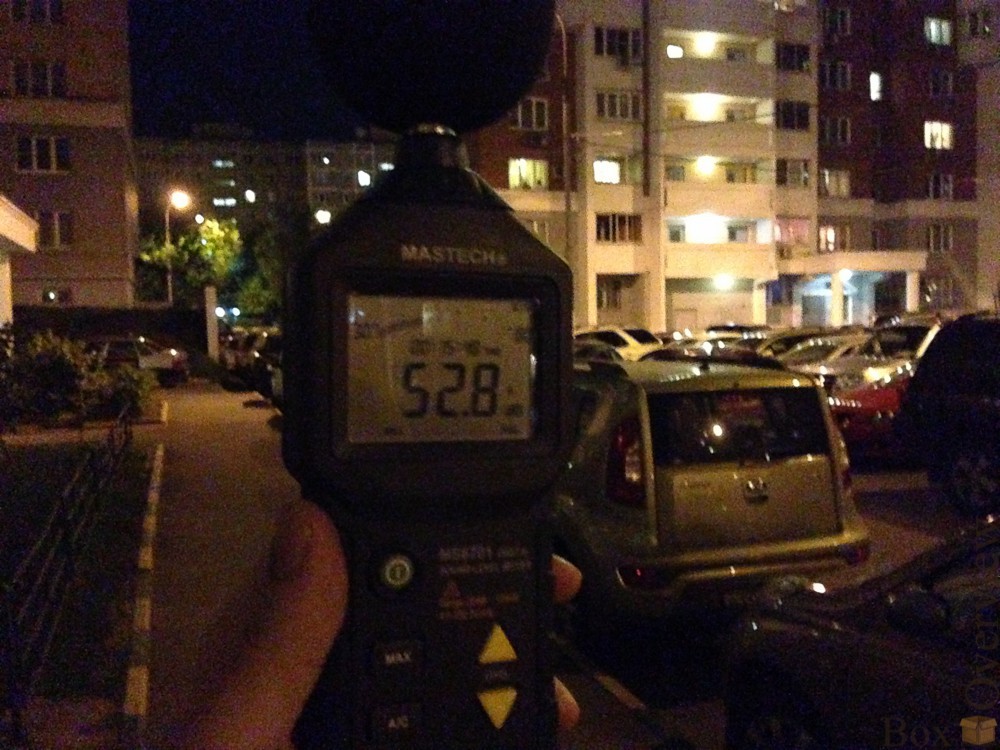
We come closer to the subway - the noise becomes more:
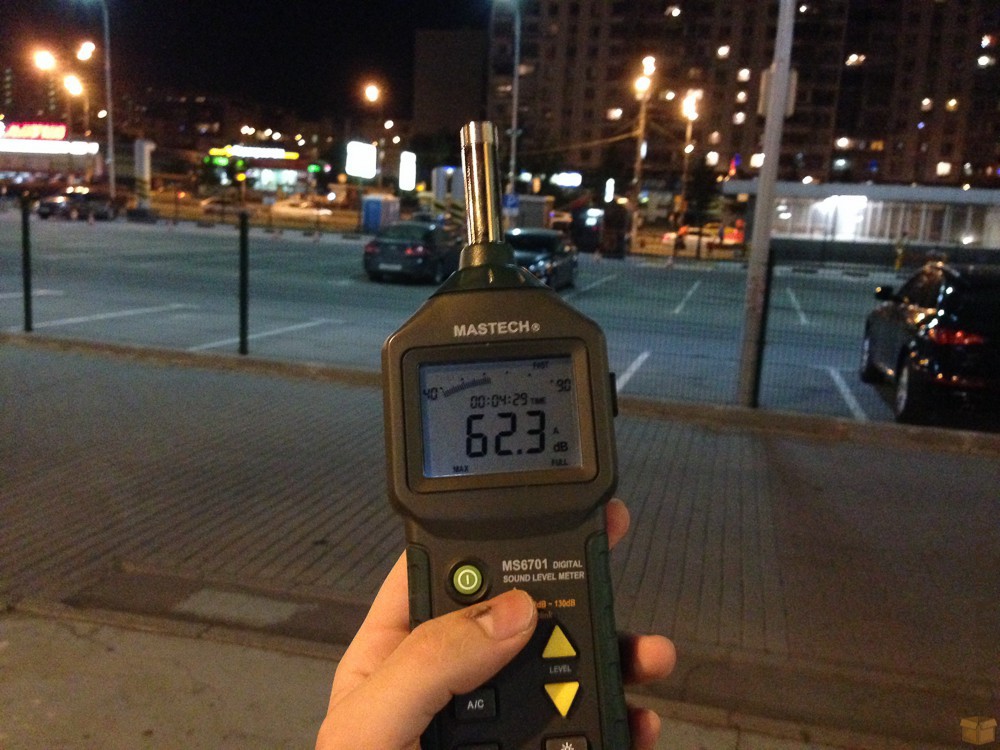
Inside the subway:

Inside the subway car moving on the surface:

Finally, the noise level in the car that moves in the tunnel :
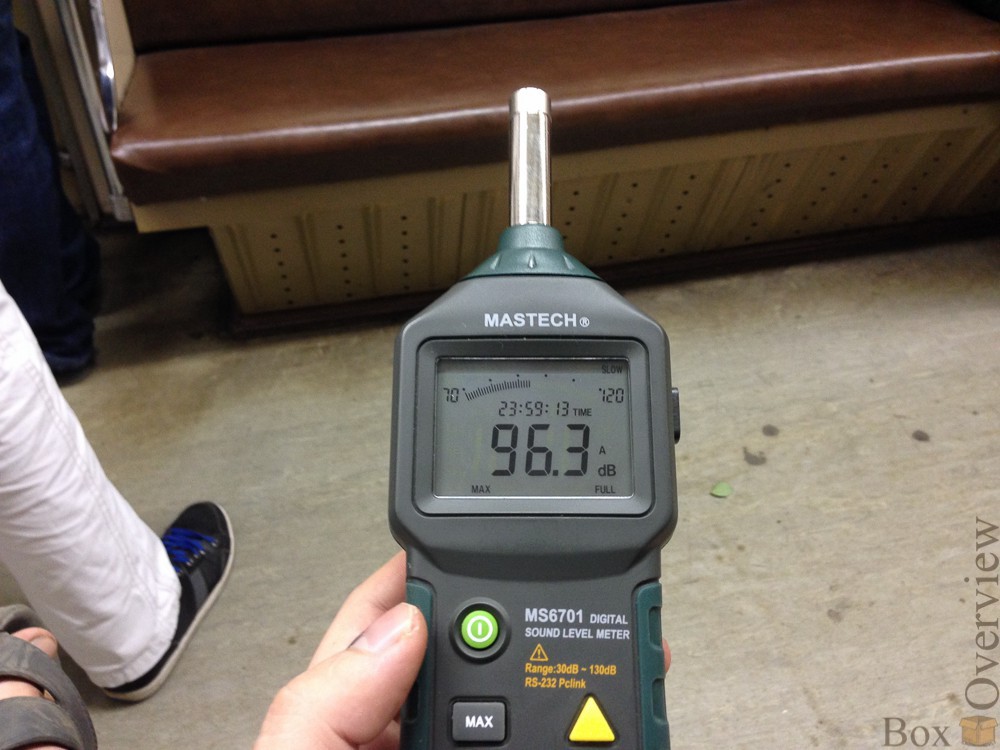
The exact figure, how many times more the volume of the train in the tunnel, count yourself. In fact, the last picture is a rather alarming factor - the prolonged exposure to noise at such a volume (more than a couple of hours a day) is already beginning to have a bad effect on hearing - the thin design of the ear stops working correctly, and the person stops hearing quiet sounds. According to various sources, hearing loss from loud noise with time can be from 10 to 30 decibels. A man travels a couple of years on the subway (especially in old cars - they are the most noisy) and his position in the “barely audible” sign goes down - first the watches are no longer audible, then a whisper, then a ticking of wall clocks at night ... And then you have to buy hearing aid. I'd rather buy headphones now. And how much do they reduce the noise?
Now that we are armed with theoretical knowledge, one can understand how much this is -95% noise, as the inscription on the box with headphones promises us.
If we remove 95% of the noise, it will mean that we will have only 5% of the 100% noise left - that is, the amount of noise will fall 20 times. Reducing noise by 20 times is minus 13 decibels. True, offsite says about -30dB in the first and second modes, which is somewhat at odds with the inscription on the box.
But here it is important to understand that the spectrum of noise is not always uniform, and the sensitivity of hearing to different frequencies is also different (remember the lines are equal to loudness). Sometimes it is not necessary to cut the entire spectrum by 30 decibels, and it is enough to lower the volume of only low-frequency sounds - the most disturbing part of the sound.
Personal impressions
If we talk about my impressions of headphones, then I’m, if not completely delighted, then in a state close to it.
Previously, I had to turn up the volume in order to hear music in the subway normally (the main source of loud sounds in my life is still the subway), and this made my ears very tired - leaving the subway, I gladly took off the headphones. Well, I had to constantly jerk the volume slider back and forth, depending on how loud the external noise was - I was uncomfortable listening to music at loudness “for the subway” on the street or in the building, and listening to the subway at the “office” loudness is impossible - nothing Can not hear.
Now the situation has changed - I listened to music at a much lower volume, and it became almost constant - when around loudly, the headphones quenched the extra sounds, allowing you to listen (and hear) the sound at low volume.
It looks like this: I go to the subway, put on headphones, turn it on. 1 ... 2 ... 3 ... Hop, the low-frequency part of the noise disappears abruptly, as if at a concert the subwoofer was turned off. The noise does not disappear completely - its level is simply reduced, and unevenly across the spectrum. Headphones with the included shumodavom feel funny - something like the sensations of a sharp change in height when the ears lay.
But this is still an audio effect, and after turning on the music, he is disturbing.
In the plane, the headphones also work out perfectly. The truth had to fend off the flight attendants, who demanded to turn off all electronic devices.
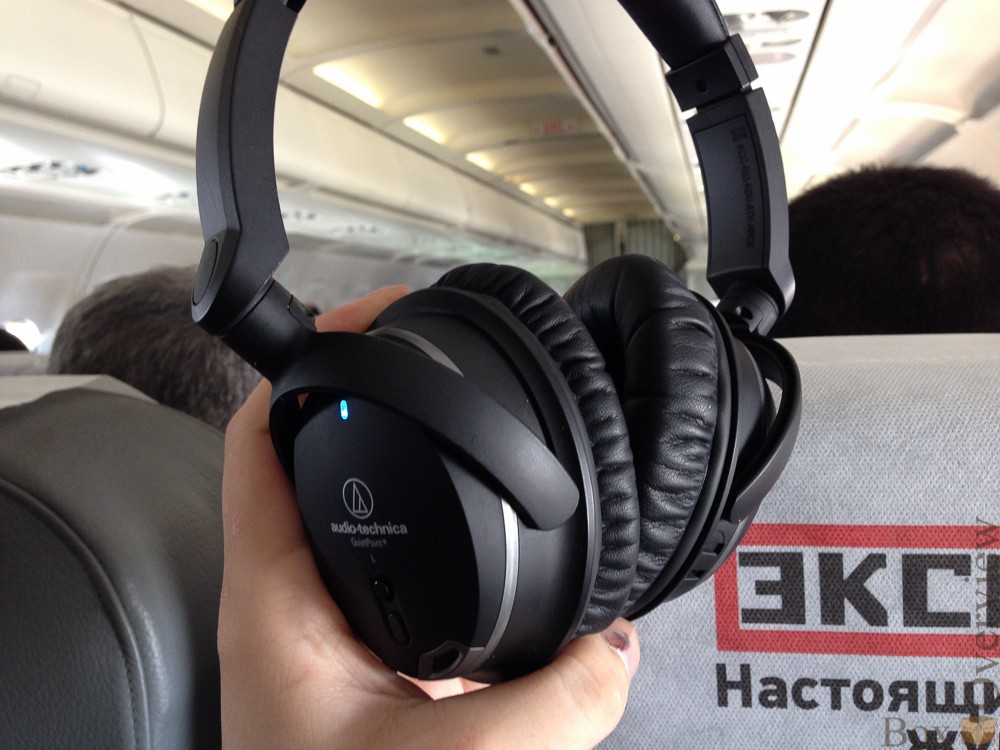
But then, wearing headphones, I finally stopped hearing engine noise and worked relatively calmly.
In rooms with low loudness of noise - auditoriums, offices, and so on, noise alone does not help much - it reduces the volume of conversations, but the ear adjusts, increasing the “gain”, and conversations still remain audible. “Wearing headphones and plunging into complete silence” will not work - the sound will still penetrate into the ear through all the insulation, the bones of the skull, etc. But the reduced noise has one big plus - it is easily interrupted by any unobtrusive music at low volume, after which only music can be heard in the headphones. Instead of music, you can use different noises - the sea, rain, forest with the same effect.
True, headphones in a quiet room are useless - it feels like they turn on about 20 dBA when turned on, so if there is silence in the room and no one is talking, then listening to music in them with the noise turned off is more convenient.
In the end, one way or another, I solved the problem of music in noisy places.
True, now I had another problem. I can no longer ride without headphones on the subway. Even if I do not want to listen to music, I still put them on and turn on the noise. Got used to
Working hours
The declared operating time from one AAA size battery is 40 hours. In practice, it turns out this picture:

I listened to music quite actively these days - on average, 6 hours per day, so we can assume that the stated working time roughly corresponds to the real one: 7.25 * 6 = 43.5 hours of work, on average, from one battery.
It is frustrating that the battery voltage is not shown in any way - you can find out that it has sat down only after the fact - the headphones begin to turn off with loud external sounds, trying to extinguish the sudden change in volume. It looks (rather, if we are talking about headphones), it is rather unpleasant - after a loud sound, the music just disappears for about 5 seconds.
Of course, any problems with batteries will not prevent you from using headphones just like ordinary headphones - just set the switch to the off position, and you can continue to listen to music without the battery. Nevertheless, it is still advisable to carry a backup battery with you if you don’t want to lose noise reduction in the middle of a trip to the subway.
Advantages and disadvantages
 They work. No, they really give the ears to rest in especially noisy places, and their owner - to listen to music, without twisting the volume to maximum.
They work. No, they really give the ears to rest in especially noisy places, and their owner - to listen to music, without twisting the volume to maximum.
 Headphones can be easily customized for any head - a large supply of the length of the arms and rotating cups (sorry, only 90 degrees in one direction)
Headphones can be easily customized for any head - a large supply of the length of the arms and rotating cups (sorry, only 90 degrees in one direction)
 The inability to fold the headphones, and as a result - the headphones take up quite a lot of space, both in the case and without it.
The inability to fold the headphones, and as a result - the headphones take up quite a lot of space, both in the case and without it.
 Headphones are designed for people without glasses. Any gap between the ear cushions and the head contributes to the penetration of third-party sounds. This is especially noticeable when you press the headphones to your head more strongly with your hands - those remnants of external sounds that you can still hear immediately weaken greatly. I had to order glasses with thin wire arms to avoid this.
Headphones are designed for people without glasses. Any gap between the ear cushions and the head contributes to the penetration of third-party sounds. This is especially noticeable when you press the headphones to your head more strongly with your hands - those remnants of external sounds that you can still hear immediately weaken greatly. I had to order glasses with thin wire arms to avoid this.
 There is no indicator or low battery signal
There is no indicator or low battery signal
 In the summer, after a few hours of walking in their ears, they sweat :(
In the summer, after a few hours of walking in their ears, they sweat :(
Links
 Headphones page on engadget
Headphones page on engadget
 Yandex Market (average price is 9990)
Yandex Market (average price is 9990)
 MobileReview Overview
MobileReview Overview
 Offsite page
Offsite page
My colleague frag1k already wrote about the junior headphones of this series - ANC7 , and I will tell you about the older version - ANC9.

Content
- Appearance
- Interior
- Specifications
- What is decibels
- Maximum volume
- How does the ear
- Personal impressions
- Advantages and disadvantages
- Working hours
Under the cut, a traditional educational program in physics, medicine, biology, geek-porn, and, well, a review of headphones, not without it.
Appearance
What do we see immediately after we removed the box with headphones from the store? We see a box. The box looks like this:
It has the proud inscription that the headphones quench up to 95% of external noise.

The headphones themselves look like this:

On one side are the mode indicator, a mode switch button and a power switch.

The button cyclically switches the three modes of noise cancellation, the current is indicated by a three-color LED. The mode is saved when you turn it off (when you turn on the headphones, they will work in the mode set when turned off):

On the box there is a transcript of these modes:

As the pictures say, the first one dampens the sounds of low frequency, and is intended for airplanes, trains and various mechanisms. The second mode reduces higher-frequency sounds - conversations, different noises. The third is a low-power mode, and can be used for relatively quiet rooms.
')
There are two noticeable holes for microphones (we'll talk about them later):

Below - a hole for the plug wire:

In the inserted state, it looks like this:

The wire is very thin and looks unreliable. Although its replacement in the event of a breakdown will not be a problem - jack-jack wires are sold anywhere.
On the other side of the headphones are the same microphone holes:

And battery connector:

It is rather strangely made, not with a lid, but with a removable compartment:

To replace it, you need to pull it out completely, and then it looks like this:

Replacement, by the way, is very difficult, if you don’t have something sharp like a screwdriver or a knife - the battery doesn’t come out of the compartment with your fingers, I broke my nail trying to do it. It is possible that the extended acrylic nail is able to do this, but I have relatives and are not so strong. I use a screwdriver from the multitool.
From the good - a very large range of adjustments, from this:

Before this:

They'll get even a big head. The cups themselves also have an independent “suspension”, they can rotate from the maximum angle:

To minimum:

Adjustments will be enough for any head, but the clamping force is still not enough, in my opinion. Headphones are very critical to the correct fit - sometimes, to achieve the maximum effect, they need to be moved on the head so that they surround the ears more closely. And then it is felt that if you press the cups with your hands, the external sounds disappear completely. But the headphones themselves are not capable of providing such a clamp, unfortunately.
Headphones do not leave the impression of strong and able to withstand any test. No, of course, they are collected well, and are not going to fall apart on their heads. Moreover, during the repair , I beat my head and headphones on the head about the protruding objects quite a couple of times, and they are still alive. The worst thing that happened to them - a few subtle scratches.
But to carry in a backpack in the same compartment with different angular and possibly sharp objects, like my previous Philips The Stretch, I would not. Apparently, manufacturers understand this, because the bundle includes a rather convenient case that will protect the headphones from the aggressive environment of my backpack:

With company label:

And for some reason, a carbine:

Why he, I did not understand. It is inconvenient to hang the case - it is too big for this, there is nothing to hang on it either. The only thing I came up with is that they can troll subscribers in an instagram (by the way, subscribe ).
It is bad that the headphones in this case take up quite a large part of the backpack.

In addition to headphones, the case is full of free space:

And there is a convenient pocket:

In which the complete set of headphones fits:

The battery also comes bundled, which pleases. In addition to it there are adapters for aircraft and 6.3mm:

And two wiring - with or without a headset. They differ in connectors:

The one with 4 pins is with a headset. Apple's standard, but most phones now seem to understand it - my Xperia Z works correctly with both a microphone and a button.
On the headset wire is, in fact, a headset with a button and a microphone on the back:

UPD: These lines are written a month after I wrote about the backpack and cover. My innate laziness made me check the strength of the headphones - I stopped carrying the case completely, leaving it to live at home, and began to wear headphones with me. They endured. They held my backpack , in which in the section with headphones there are keys, handles, trifles, pliers, a knife, screwdrivers, wiring with connectors and many other sharp and hard pieces.
We withstood the rain and wind (see the title picture), daily trips to the subway, airplane flights in luggage and hand luggage, weathered drops from the head and head-butts on protruding objects.
I admit, I was wrong. Headphones durable and withstand everything. But why then they cover?
Interior
Naturally, any device must be disassembled. After not having disassembled it, we cannot be considered its full-fledged owner. If we took apart even the multicookers, then we will sort the headphones even more. Remove ear cushions, gently tightening the fabric from the sides:
We see the noise reduction microphone and speaker. The bulge below the speaker is the battery compartment.

Naturally, the second earpiece is the same, but empty - so that both cups have the same sound characteristics:

We unscrew the three screws in the depth of the earpiece and removing the outer cap, we get to the most delicious - the board:

What we have here is interesting? For example, a double switch. More precisely, even two dual switches - each for two channels:

It is necessary to work without a battery - in the off state, the sound is transmitted directly to the speakers, without getting into the audio path, which cannot operate without power. And when you turn on one switch physically chops off the sound source from the speakers, redirecting it to the amplifier, and the second supplies power to this same amplifier.
Below is the button for changing modes:

And above - LED indication modes:

Some kind of connector for debugging or programming:

Two incomprehensible chips, with similar markings that could not be found. That it remains only to guess - maybe DSP for different channels, maybe something analog, maybe ADC and DAC.

Like the previous two, the appointment of this chip is also a mystery:

To be honest, I'm a little sad. Disassemble something dismantled, but to understand the meaning of the work is not particularly close.
Go ahead. Microphone:

Moreover, one. No, that's right - we were promised two microphones, we have two microphones, one inside and one outside. Just funny is that the lower mesh, which looks like another microphone turned out to be a sham:

You can still open the second earpiece, but we will not see anything particularly interesting there - a small scarf, the only purpose of which is to connect the wires. From it it is clear that the headphones connect 6 wires:

Also located on this part: a microphone (and another inside), battery contacts:

By the way, the insides have changed quite a lot compared to the previous model:

I have little knowledge of audio technology, but it seems to me that part of the analog path was replaced by a number.
Specifications
Honestly, I don’t really look at the characteristics, but some people prefer to listen to headphones instead of music :)Especially for them - a sign:
| Emitter | Dynamic (Neodymium, 40 mm) |
| frequency range | 10 Hz - 25 kHz |
| Noise reduction level | up to 30 dB depending on the mode |
| Impedance | 100 ohm |
| Cable | 1.2 m (removable, in two versions) |
| Plug | 3.5 mm |
| Type of | Monitor |
| Acoustic design | Closed |
| Weight | 220 g (without cord and battery) |
If everything is clear with the weight, type, frequency range, cable and plug, then with the item “Squelch level: up to 30 dB, depending on the mode,” questions arise. How many times does the noise decrease? What are these decibels? Well, well, since there are questions, you will have to answer.
What is decibels?
I remember from school that the sound volume is measured in decibels. And in some children's encyclopedia there was a picture from which I firmly remembered that the noise of a rocket taking off was 150 decibels, and that it was above the pain threshold. True, I never saw a rocket taking off in my life.But if I had been asked about what kind of value this is - decibels, I could not answer. Honestly, in a school textbook, some kind of turbidity was written: “Unit of measure in 1 decibel (dB) is defined as the decimal logarithm of the quotient between two physical quantities for which the unit of measure is power (energy per unit time)”
Well, who in their right mind, without need, will try to comprehend this sentence? No one. It is easier to memorize and tell at the exam, but it is not necessary to understand this. In fact, everything is very simple.
We all remember Alexander Bell - the man who invented the phone (although, suddenly, Wikipedia says he didn’t invent the phone, but he invented a peeling machine, a metal detector, a vacuum pump and a kite. He also founded National Geographic).

So, in the process of studying sound processes, he also tested human hearing - determined the quietest and loudest sound that a person can hear. He applied the sound of exactly measured power to the speakers and, making a correction for the efficiency and sound absorption in the air and at the medium boundaries, determined what radiation density is needed for minimum audibility of sound, and after which
The maximum load on the ears of a healthy middle-aged person before the onset of pain was 10 watts / m². A PW is a watt of -12 degrees, or 0.000000000001 watts. Thus, a person’s ears have a dynamic range that covers 13 orders of power - in order to get the loudest sound, you need to amplify the quietest 100,000,000,000 times. Cool! It is like a power supply that can produce voltages from 1 volt to 1000 kilovolts. Like a car, the engine of which can vary power from the power of a small kettle (horsepower, 700W) to 7 petawatts (for comparison, the power of all nuclear power plants in the world is estimated at 0.4 terawatts, or 0.004 petawatts). Apparently, Bell, too, was a little ohrenel from this, and did not come up with anything better than how to divide the entire range of hearing into 13 parts and call them in his honor - white. It turns out that when you increase the volume by 1 white, the power (and the volume) of the sound increases 10 times. Two times - 100 times, and so on. However, later it turned out that the white is too large a unit, and it is not very convenient to use it (the size of bacteria can also be measured in millimeters, but it is much more convenient to do it in micrometers), so they began to use DBS - 1/10 of the white. Accordingly, an increase of 1 dB is an increase of approximately 1.26 times. If ten times multiplied by 1.26, you get 10.
Well, about 10: 1.26 * 1.26 * 1.26 * 1.26 * 1.26 * 1.26 * 1.26 * 1.26 * 1.26 * 1.26 = 10.08568
The most important thing - you need to understand that the decibel itself is a dimensionless quantity, even though it pretends to be dimensional. Without reference to the zero value, the decibel only shows how many times the value has changed. If we say that the sound level fell by 5 decibels, this means that its power compared to the previous value fell 3 kopecks times (10 ^ (5/10) = 3.16). And if the power is raised 50 times, it will give +17 dB to the volume (10 * lg (50) = 16.99)
But how, if decibels are a dimensionless quantity (as percentages), do they measure loudness, power, voltage, and so on? Very simple - taking for zero dB any value (it is called the reference). The value in each case is different, because zero for the reference value can not be taken by definition - by increasing the zero by half, we still remain with zero. Thus, the decibel produced a whole brood of different units of measurement:
dBm (dBm) is the unit of power. It measures the power of signals (it may be familiar to you from the display on a modem or telephone), the sensitivity of receivers, the power of transmitters, and so on.
The reference level is 1 mW (this power is considered to be at a nominal load, such as 50 ohms for radio engineering). Thus, a 20 mW signal is 13 dBm, and a 0.3 mW signal is -5 dBm

One of the variants of the signal indicator in the CM shows just the dBm value in the receiver path.
dBV (dBV) and younger brother dBuV (dBµV) are voltage units. The first is used in audio equipment, the second in radio. The reference voltages are 1 volt and 1 microvolt, respectively.
Here, for example, the screen of some device for configuring satellite antennas:

dBi (dBi) familiar to everyone who has ever chosen a router or antenna to it. Or put the satellite receiver. Fully called dull and abstruse: “isotropic decibels (decibels relative to an isotropic radiator),” but in reality everything is simple. An isotropic radiator (iso-equal from Latin words, and tropos is a character) is an antenna whose radiation pattern is a level sphere. This means that such an antenna radiates uniformly in all directions. There are no such antennas, and they are not really needed in the real world.
So, dBi shows how a real antenna with this parameter emits stronger than isotropic. I think everyone understands that the antenna cannot radiate more strongly than the transmitter, therefore the gain is achieved due to the compression of the radiation pattern - the antenna radiates more to one side than the other. The situation is about the same as with photographic equipment, only instead of the transmitter power - the number of pixels on the matrix, and instead of the antenna - the lens. By changing the lens on the telephoto you won’t achieve an increase in the resolution of the photo, but by reducing the field of view, the quality of the photo of a distant object will be better for you. True, another problem arises here: those who shot with a telephoto know how difficult it is to keep a remote object in the frame without a tripod. With antennas, the same problem - even the best narrowly focused antennas are not very precisely directed at each other, will not work, or will work poorly - the bulk of the radiation will go past and uselessly dissipate in space.
Each normal antenna in the description has a picture similar to this:

This is the directivity pattern. One of them shows the horizontal, and the other - the vertical directivity of the radiation.
In 3d it will look something like this:

The largest "bubble" calls the main petal (there may be several, by the way), and the rest - side or side. As a rule, they are not used in work, and therefore they are trying to get rid of them - they only draw off part of the transmitter power.
For example, here is the radiation pattern from a very directional antenna:

There is also such a tricky thing as dBFS - dB Full Scale , when the maximum value of any scale of the instrument is taken as 0 dB. If we have a voltmeter scale of 1 volt, then 0.5 volt it will be -6 dB.
Here is the scale of my voice recorder with dBFS:

It is necessary mainly for digital recording - the ADC is adjusted to the maximum volume level in order to avoid overloading - clipping. Suppose if you have a signal with an amplitude of one and a half volts, and you adjust the upper limit of the ADC input to 1.6 V in order to get a signal of a higher resolution from the output. But now, if you give a signal with an amplitude greater than one and a half volts - for example, two, then the output of the ADC will still be equal to one and a half volts, because the ADC simply does not have enough capacity to show you two volts. Accordingly, the information contained in the part of the signal exceeding one and a half volts will be lost when digitizing. Therefore, everyone familiar with the sound knows that a positive value (and even a zero value, the more common values are -9 or -18) dBFS is very bad, and needs to be corrected - as a rule, simply lower the volume of the input signal by reducing the gain, or connect a compressor / limiter that does the same thing, but only on problem areas.
But something I digress. Noise is also measured in decibels, and the unit is called dBSPL (dB Sound Pressure Level) . The sound pressure acts as a reference level, below which a person is not able to catch a sound - 20 μPa at a frequency of 1 kHz.
It is in these units that all sound level meters measure noise, although they are often not written about it. In addition, correction meters are necessarily present in the sound level meter, denoted A, B, C. They are necessary in order to bring the flat sensitivity of the microphone (it is also not flat, but at operating frequencies it also leads to flat) to the sensitivity of the human ear. It is not only not the same at different frequencies, but it also varies depending on the volume. Information about the sensitivity of the human ear, combined in one graph looks like this:

The lines themselves are called isophones, and together they make up a family of lines of equal loudness.
For example, the “0” point is precisely the quietest sound (20mKPa / 1kHz) that people can hear. However, the graph shows that at a frequency five times higher a person is able to hear the sound and with less sound pressure. And at a frequency of 8 kHz, on the contrary, the sound power should be almost twice as large.Just the correction mode "A" and leads the sensitivity of the microphone to the isophones. Mode B is a type A, but mode C is pure dBSPL, sound pressure expressed in decibels.
How the rumor works
But how can the human ear perceive such a large volume range? It's all about the structure of the ear.Although, for the explanation it is worth starting with the fish. In fish, everything is arranged quite simply - their ear is combined with an equilibrium apparatus, which is also responsible for the feeling of acceleration. If we consider only hearing, then otoliths are responsible for it - calcite crystals (although not necessarily, some crayfish decided not to bother with their cultivation, and use just grains of sand instead), which are connected to sensitive cells. When a sound wave is applied to them, statoliths begin to oscillate, which causes the excitation of sensitive cells and the transmission of signals along the nerves to the brain. A sort of biological gyro:

This whole structure is immersed in a liquid (it is called endolymph), and the sound is transmitted inwards through the membrane - a thin film that prevents the delicate device from contacting the external environment, but at the expense of its small thickness successfully transmits vibrations.
In the process of human evolution (more precisely, long before a person - in the process of going to land), a problem arose - on land, it was impossible to use such a design without changes, because when a wave passes from the air to a more dense environment, large energy losses occur.

What the fish had - now it performs only the functions of the vestibular apparatus, and the duties of sound recognition are assigned to the thing called the cochlea. It is a structure of several channels whose diameter is not constant - the closer to the center, the smaller it is. Throughout the entire length of the cochlea, there are sensitive cells that react to fluctuations of the re-lymph. Here is the cool thing, the way different sound frequencies are recognized - the sound just comes into resonance with the walls of the cochlea, locally increasing the amplitude of oscillations in a certain place. High sounds will resonate with walls in the lower sections of the cochlea, and low sounds in the upper ones. In this way, you can determine the frequency of the sound from the place in the cochlea that generates the largest signal.The remaining parts, the eardrum, the hammer, the anvil, and the stirrup, form a “booster”, which, due to a cunning lever mechanism, increases the strength of sound vibrations by a factor of 20. However, due to amplitude, oscillations with a large amplitude, but with low pressure, enter the ear, and the stirrup transmits vibrations with a small amplitude to the cochlea, but with sufficient energy, so as not to fade when moving to another medium. In fact, this part of the ear is the impedance matching of water and air.
The tension of the eardrum and the position of the incus and stapes are regulated by special muscles. Because of this adaptive adjustment, the difference between the quietest and loudest sound is 13 orders of magnitude - in the absence of loud sounds, a certain period of time the muscles relax without interfering with oscillations of the ear bones. When you increase the volume, they are on the contrary, tense, extinguishing part of the movements.
Maximum volume, limits, and danger of loud noises
Despite the large range of sounds heard by the ear, and it has a limit. Here, for example, I made a compilation of several found volume tables of different sounds:
Then I walked a little with a sound level meter and confirmed the values in the table. Here, for example, the entrance of the house deep at night:

And here is the street - the noise is heard from the road:

We come closer to the subway - the noise becomes more:

Inside the subway:

Inside the subway car moving on the surface:

Finally, the noise level in the car that moves in the tunnel :

The exact figure, how many times more the volume of the train in the tunnel, count yourself. In fact, the last picture is a rather alarming factor - the prolonged exposure to noise at such a volume (more than a couple of hours a day) is already beginning to have a bad effect on hearing - the thin design of the ear stops working correctly, and the person stops hearing quiet sounds. According to various sources, hearing loss from loud noise with time can be from 10 to 30 decibels. A man travels a couple of years on the subway (especially in old cars - they are the most noisy) and his position in the “barely audible” sign goes down - first the watches are no longer audible, then a whisper, then a ticking of wall clocks at night ... And then you have to buy hearing aid. I'd rather buy headphones now. And how much do they reduce the noise?
Now that we are armed with theoretical knowledge, one can understand how much this is -95% noise, as the inscription on the box with headphones promises us.
If we remove 95% of the noise, it will mean that we will have only 5% of the 100% noise left - that is, the amount of noise will fall 20 times. Reducing noise by 20 times is minus 13 decibels. True, offsite says about -30dB in the first and second modes, which is somewhat at odds with the inscription on the box.
But here it is important to understand that the spectrum of noise is not always uniform, and the sensitivity of hearing to different frequencies is also different (remember the lines are equal to loudness). Sometimes it is not necessary to cut the entire spectrum by 30 decibels, and it is enough to lower the volume of only low-frequency sounds - the most disturbing part of the sound.
Personal impressions
If we talk about my impressions of headphones, then I’m, if not completely delighted, then in a state close to it.Previously, I had to turn up the volume in order to hear music in the subway normally (the main source of loud sounds in my life is still the subway), and this made my ears very tired - leaving the subway, I gladly took off the headphones. Well, I had to constantly jerk the volume slider back and forth, depending on how loud the external noise was - I was uncomfortable listening to music at loudness “for the subway” on the street or in the building, and listening to the subway at the “office” loudness is impossible - nothing Can not hear.
Now the situation has changed - I listened to music at a much lower volume, and it became almost constant - when around loudly, the headphones quenched the extra sounds, allowing you to listen (and hear) the sound at low volume.
It looks like this: I go to the subway, put on headphones, turn it on. 1 ... 2 ... 3 ... Hop, the low-frequency part of the noise disappears abruptly, as if at a concert the subwoofer was turned off. The noise does not disappear completely - its level is simply reduced, and unevenly across the spectrum. Headphones with the included shumodavom feel funny - something like the sensations of a sharp change in height when the ears lay.
But this is still an audio effect, and after turning on the music, he is disturbing.
In the plane, the headphones also work out perfectly. The truth had to fend off the flight attendants, who demanded to turn off all electronic devices.

But then, wearing headphones, I finally stopped hearing engine noise and worked relatively calmly.
In rooms with low loudness of noise - auditoriums, offices, and so on, noise alone does not help much - it reduces the volume of conversations, but the ear adjusts, increasing the “gain”, and conversations still remain audible. “Wearing headphones and plunging into complete silence” will not work - the sound will still penetrate into the ear through all the insulation, the bones of the skull, etc. But the reduced noise has one big plus - it is easily interrupted by any unobtrusive music at low volume, after which only music can be heard in the headphones. Instead of music, you can use different noises - the sea, rain, forest with the same effect.
True, headphones in a quiet room are useless - it feels like they turn on about 20 dBA when turned on, so if there is silence in the room and no one is talking, then listening to music in them with the noise turned off is more convenient.
In the end, one way or another, I solved the problem of music in noisy places.
True, now I had another problem. I can no longer ride without headphones on the subway. Even if I do not want to listen to music, I still put them on and turn on the noise. Got used to
Working hours
The declared operating time from one AAA size battery is 40 hours. In practice, it turns out this picture:
I listened to music quite actively these days - on average, 6 hours per day, so we can assume that the stated working time roughly corresponds to the real one: 7.25 * 6 = 43.5 hours of work, on average, from one battery.
It is frustrating that the battery voltage is not shown in any way - you can find out that it has sat down only after the fact - the headphones begin to turn off with loud external sounds, trying to extinguish the sudden change in volume. It looks (rather, if we are talking about headphones), it is rather unpleasant - after a loud sound, the music just disappears for about 5 seconds.
Of course, any problems with batteries will not prevent you from using headphones just like ordinary headphones - just set the switch to the off position, and you can continue to listen to music without the battery. Nevertheless, it is still advisable to carry a backup battery with you if you don’t want to lose noise reduction in the middle of a trip to the subway.
Advantages and disadvantages
 They work. No, they really give the ears to rest in especially noisy places, and their owner - to listen to music, without twisting the volume to maximum.
They work. No, they really give the ears to rest in especially noisy places, and their owner - to listen to music, without twisting the volume to maximum. Headphones can be easily customized for any head - a large supply of the length of the arms and rotating cups (sorry, only 90 degrees in one direction)
Headphones can be easily customized for any head - a large supply of the length of the arms and rotating cups (sorry, only 90 degrees in one direction) The inability to fold the headphones, and as a result - the headphones take up quite a lot of space, both in the case and without it.
The inability to fold the headphones, and as a result - the headphones take up quite a lot of space, both in the case and without it. Headphones are designed for people without glasses. Any gap between the ear cushions and the head contributes to the penetration of third-party sounds. This is especially noticeable when you press the headphones to your head more strongly with your hands - those remnants of external sounds that you can still hear immediately weaken greatly. I had to order glasses with thin wire arms to avoid this.
Headphones are designed for people without glasses. Any gap between the ear cushions and the head contributes to the penetration of third-party sounds. This is especially noticeable when you press the headphones to your head more strongly with your hands - those remnants of external sounds that you can still hear immediately weaken greatly. I had to order glasses with thin wire arms to avoid this. There is no indicator or low battery signal
There is no indicator or low battery signal In the summer, after a few hours of walking in their ears, they sweat :(
In the summer, after a few hours of walking in their ears, they sweat :(Links
 Headphones page on engadget
Headphones page on engadget Yandex Market (average price is 9990)
Yandex Market (average price is 9990) MobileReview Overview
MobileReview Overview Offsite page
Offsite pageSource: https://habr.com/ru/post/222999/
All Articles
